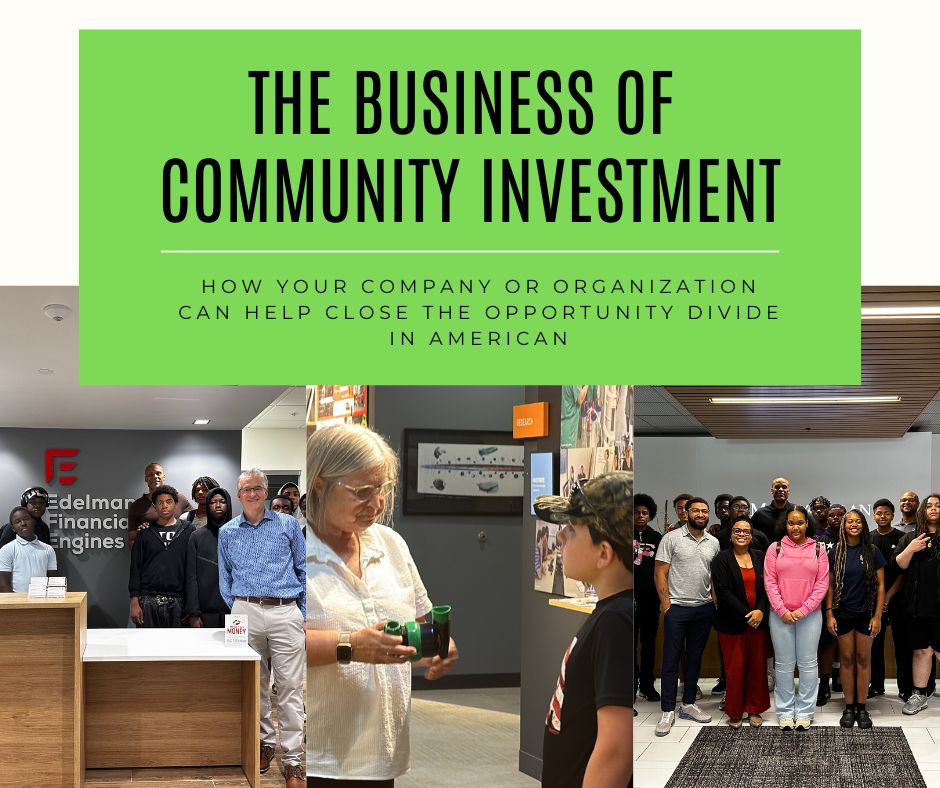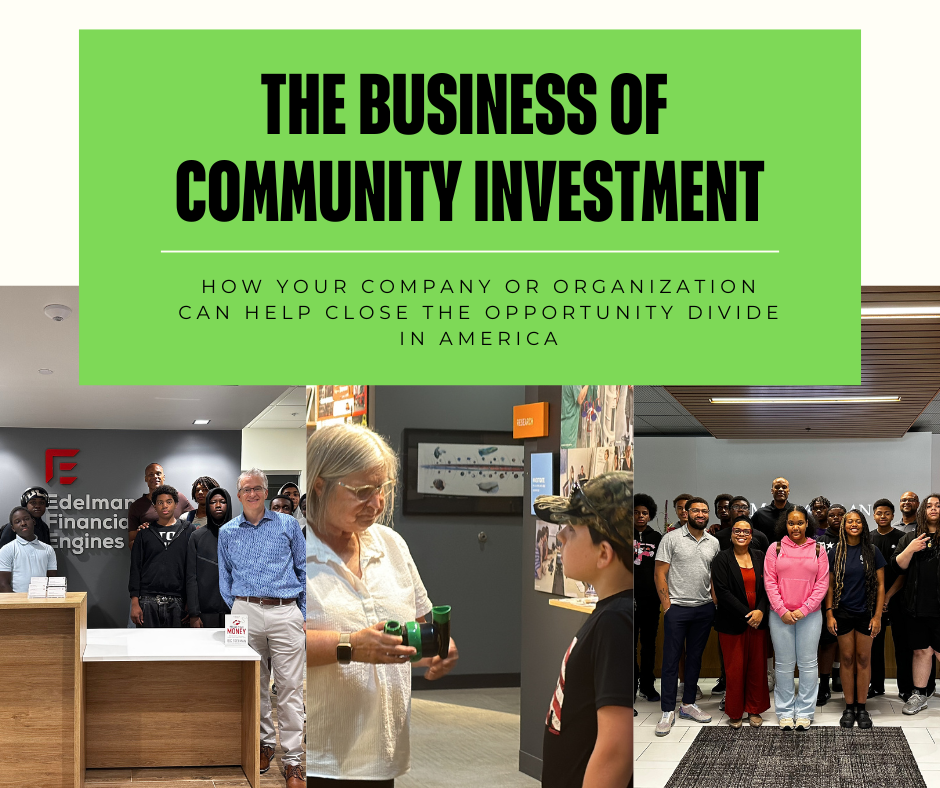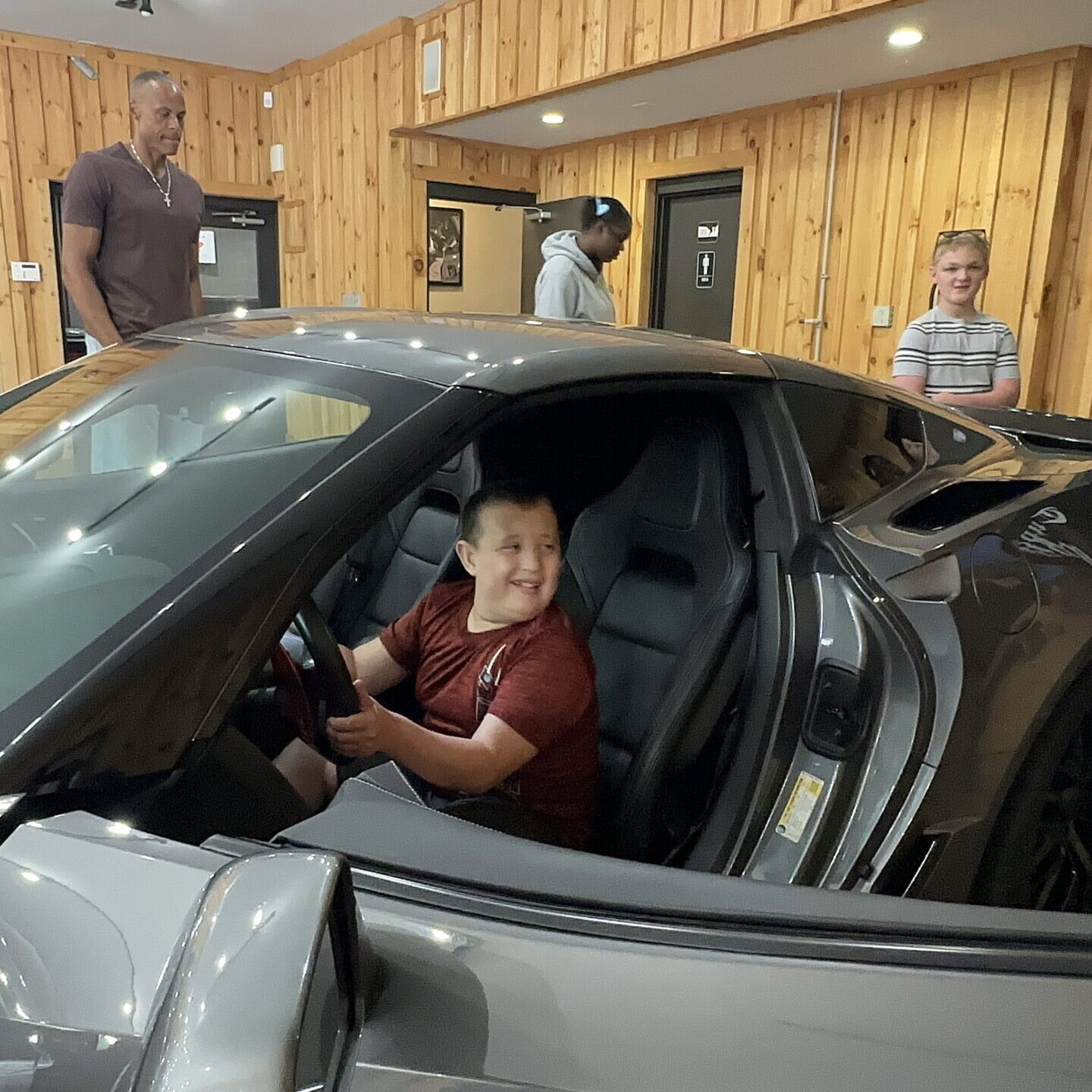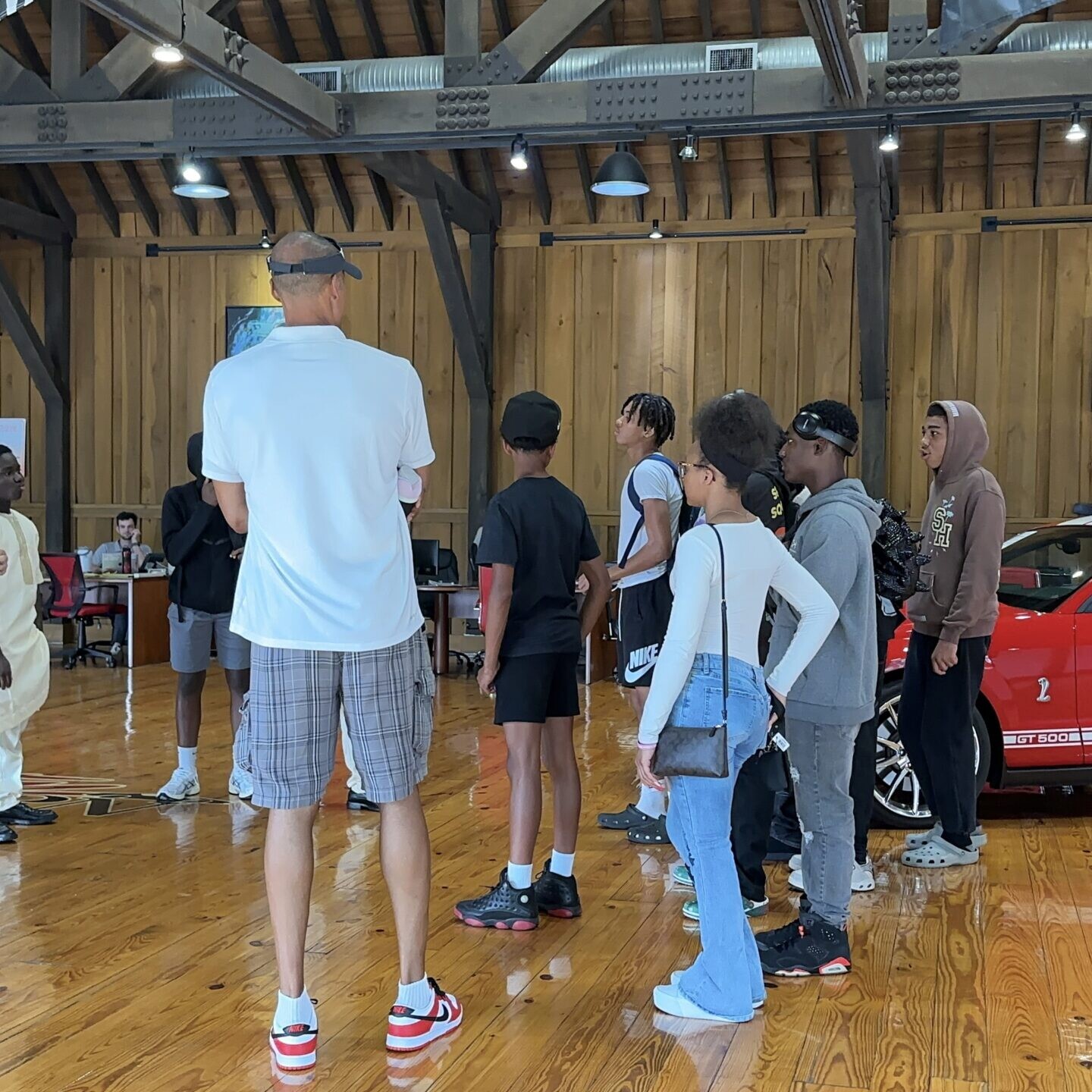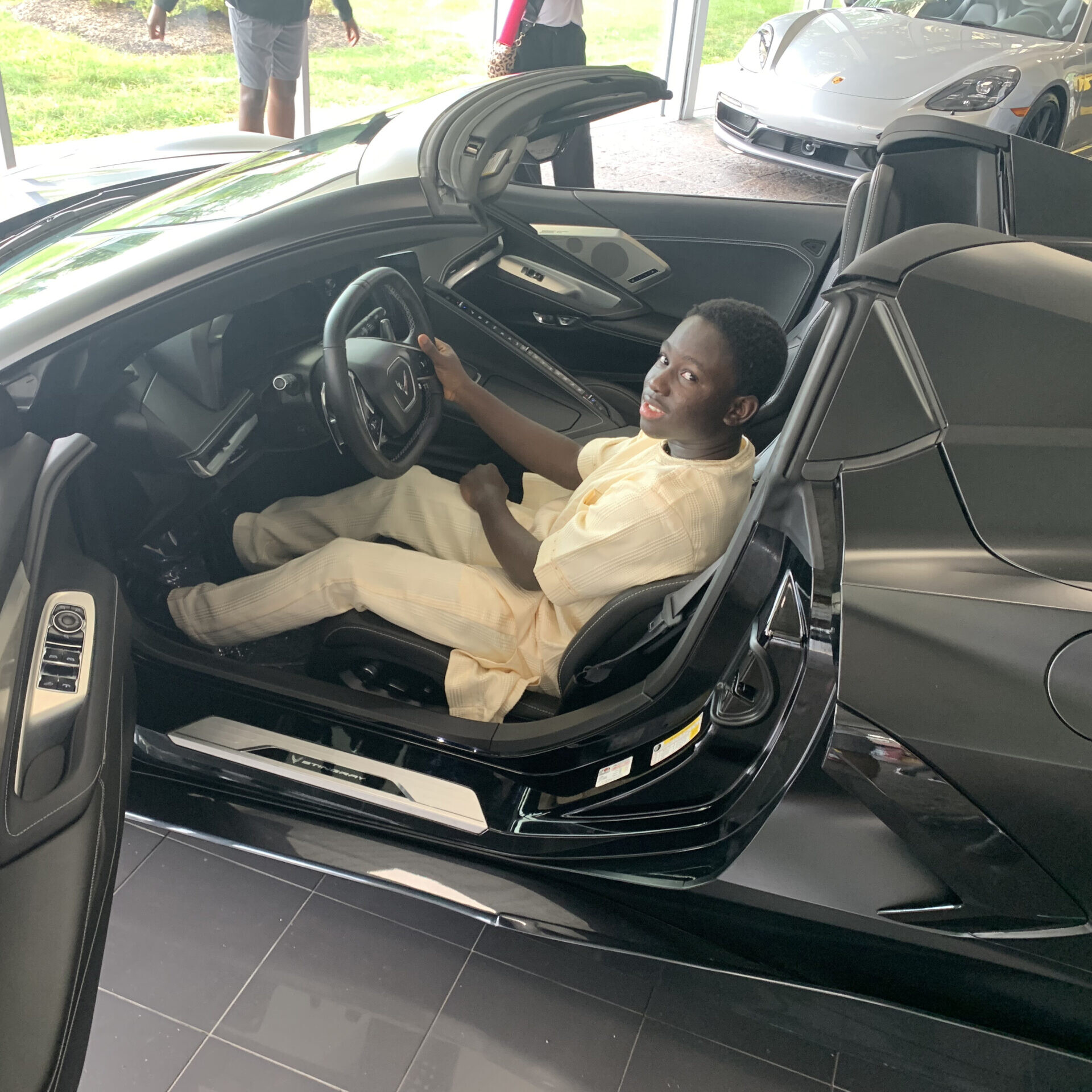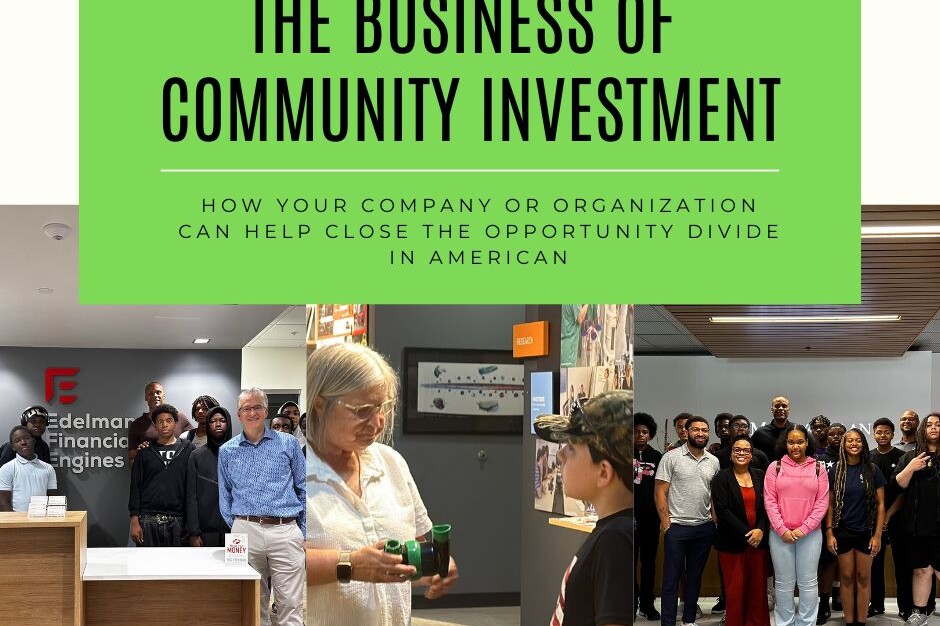The Business of Community Investment
A Tribute to LFYO's 40 Business Partners
Brace yourself. If you don’t like personal and professional call-outs, really call-ups, then reading this article might set off your discomfort alarm bells. So be it, because our most vulnerable youth are in big trouble and they don’t even know it. That’s why we (you and I) need to do more. A whole lot more — right now! Writing checks to or volunteering at a local nonprofit organization is great. But here’s an even better alternative for high-impact companies with a social mandate: opening their doors so at-risk youth can see success up close, in real time. To learn what it takes to find a good job or start a thriving business. To discover where their skillset will be best used and most appreciated. To understand why they don’t have any time to waste in a highly competitive (and AI job-shrinking) labor market. You see, a lack of vision is arguably the biggest reason why young people from disadvantaged backgrounds check out. At school. On cue. In life. They often have nothing to look forward to regarding favorable outcomes in the future, which is why their interest capital is usually spent on what makes them feel good at the present moment. Here, their mood drives their mode. In other words, feelings (and not values) serve as their de facto guide. That’s a bad place for anyone to be, let alone a young person with a malfunctioning internal navigation system.
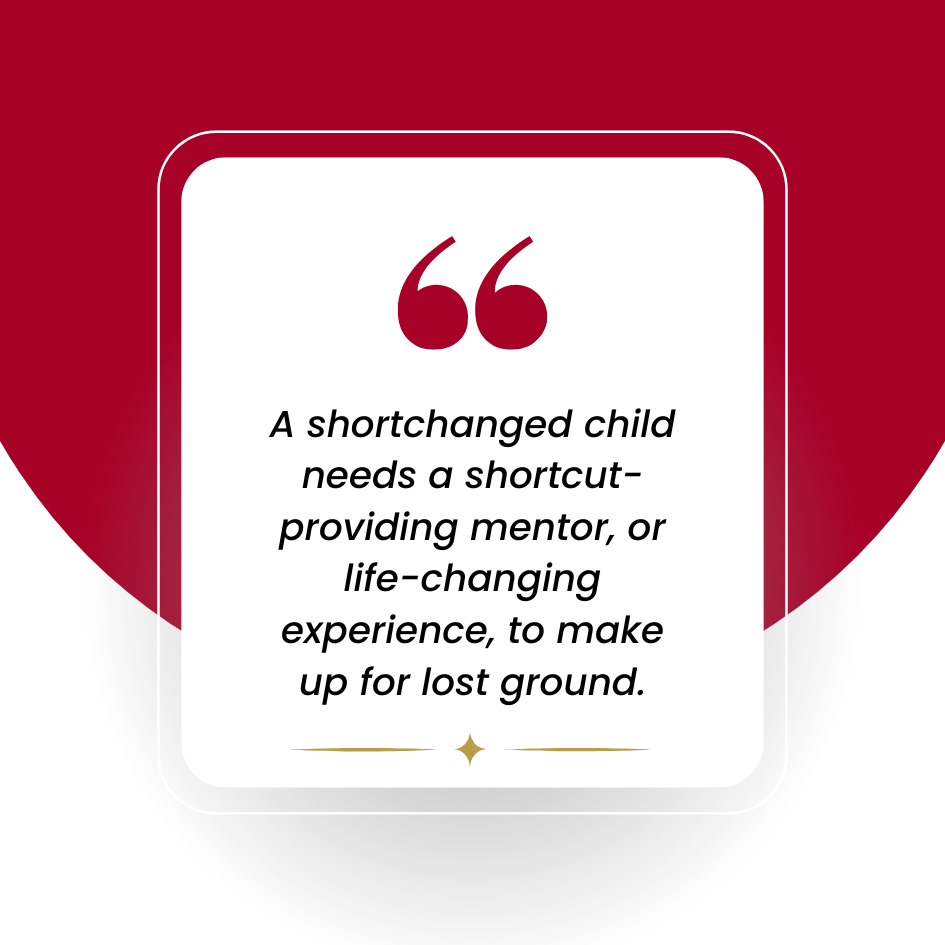
Solving problems. Following instructions. Producing results. Assessing (and taking calculated) risks. Maximizing opportunities. Controlling emotions. Handling pressure. Completing projects — on time and within budget. Working efficiently. Collaborating effectively. Communicating clearly. Embracing change. Inspiring others. Recognizing (and preventing) mistakes. Developing talents. Giving back. Dreaming big. These are the “soft” and “hard” skills employers expect, among others, from today’s multifaceted employees. And targeted brain development in these skill-building areas — inside and outside of traditional schooling — is critical to helping disadvantaged youth get up to speed in a dynamic and ever-changing employment landscape. Check this out. A shortchanged child needs a shortcut-providing mentor, or life-changing experience, to make up for lost ground. Vulnerable students, in the majority of cases, are way behind academically and inspirationally. Multiyear academic deficiencies and multigenerational systemic inequities are hard, if not impossible, to close without a bridge-building catalyst in place. Enter unforgettable field trips to area businesses to help connect the relevancy dots. Let me explain.
Although a lot of work for LFYO and our business partners, it is well worth the effort. On our end, we must align in-class activities with real-world applications before going on field trips. Without context, inner-city kids are totally lost in translation. No frame of reference, no short- or long-term buy-in. The result? Opportunity wasted, and worse, the learning experience will likely be immediately stored under the “pain avoidance” category in their amygdala, also known as the emotional memory center. That’s why we use sensory-based learning modalities (in the form of customized PDF games on iPads) to draw youth in. Overlay the fun, underlay the fundamentals — as in lessons learned, knowledge gained, and dream(er/ing) restored. For disadvantaged students, the field trips should be an engaging, exciting, and empowering experience.
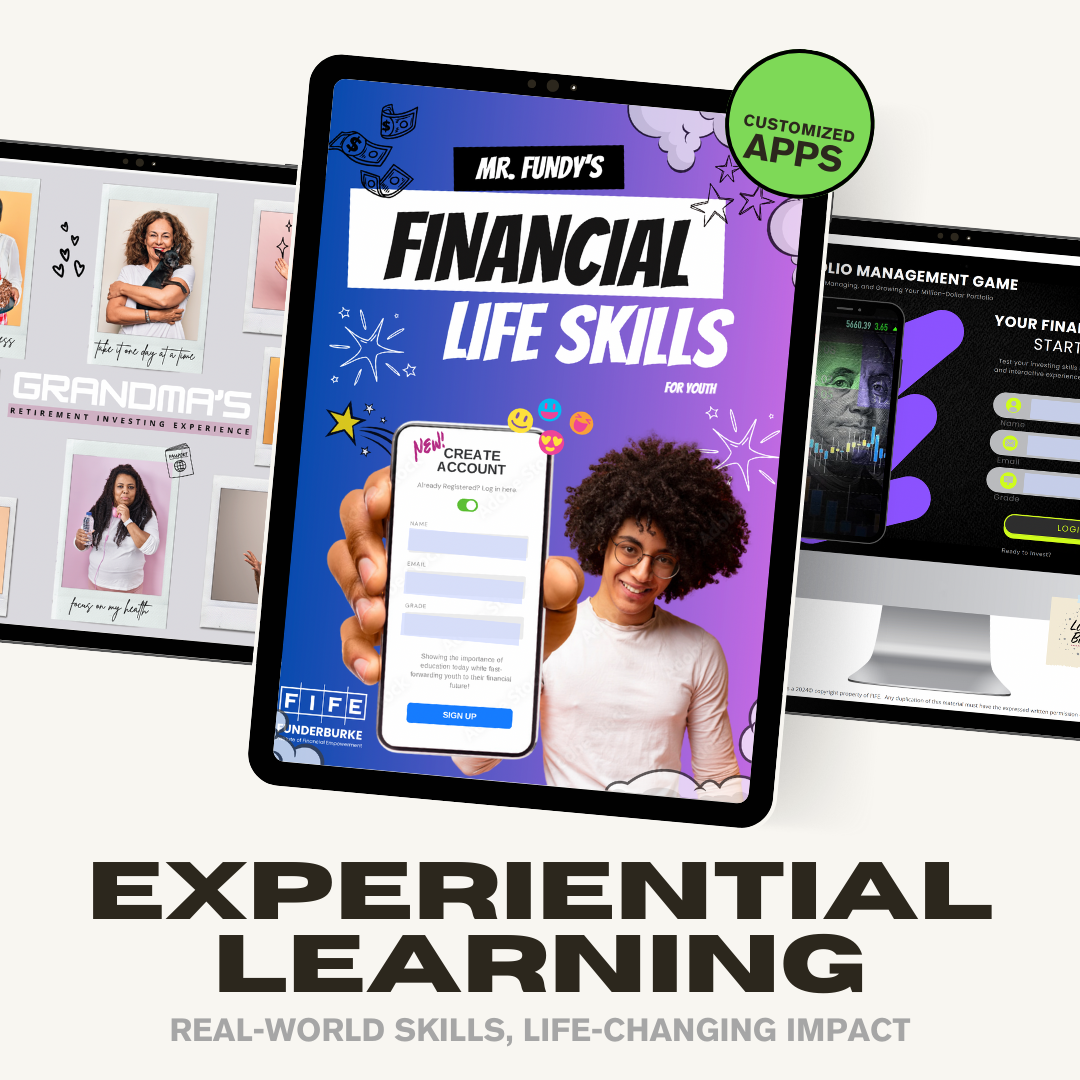
With engagement, make them feel welcome the moment they enter the building. In fact, meet them outside just as they’re approaching the front door. Throw on a radiant smile. Offer a handshake (or dap if you’re a germaphobe like me), followed by an upbeat introduction. Remember: It’s your responsibility to establish the oxytocin bond right from the onset, not theirs. For some businesses, excitement is the hardest thing to pull off. Sorry traditional banks, engineering firms, and manufacturing companies, to name a few — I’m just saying. Don’t fret; be creative. Limit the lectures (that will lead them to boredom) … pass around the fixtures (that they can hold as future product designers) … highlight the features (that they’ll one day have access to as investors or homeowners) … allow the gestures (that they can freely express without being judged). Engagement is good, excitement is better, but empowerment is best. Empowerment is the litmus test for every field trip experience, which may take days, weeks, months, years, or decades to pay off. When it happens, attitudes improve, perspectives shift, and behaviors change. Yes, this is easier said than done. Again, it’s a lot of work, but there is a workable solution to closing the opportunity divide in America. One-third is on their frontline support system (caregivers, family members, and educators), one-third is on us (nonprofit organizations, social service agencies, and community-minded investors), and one-third is on them (at-risk youth).
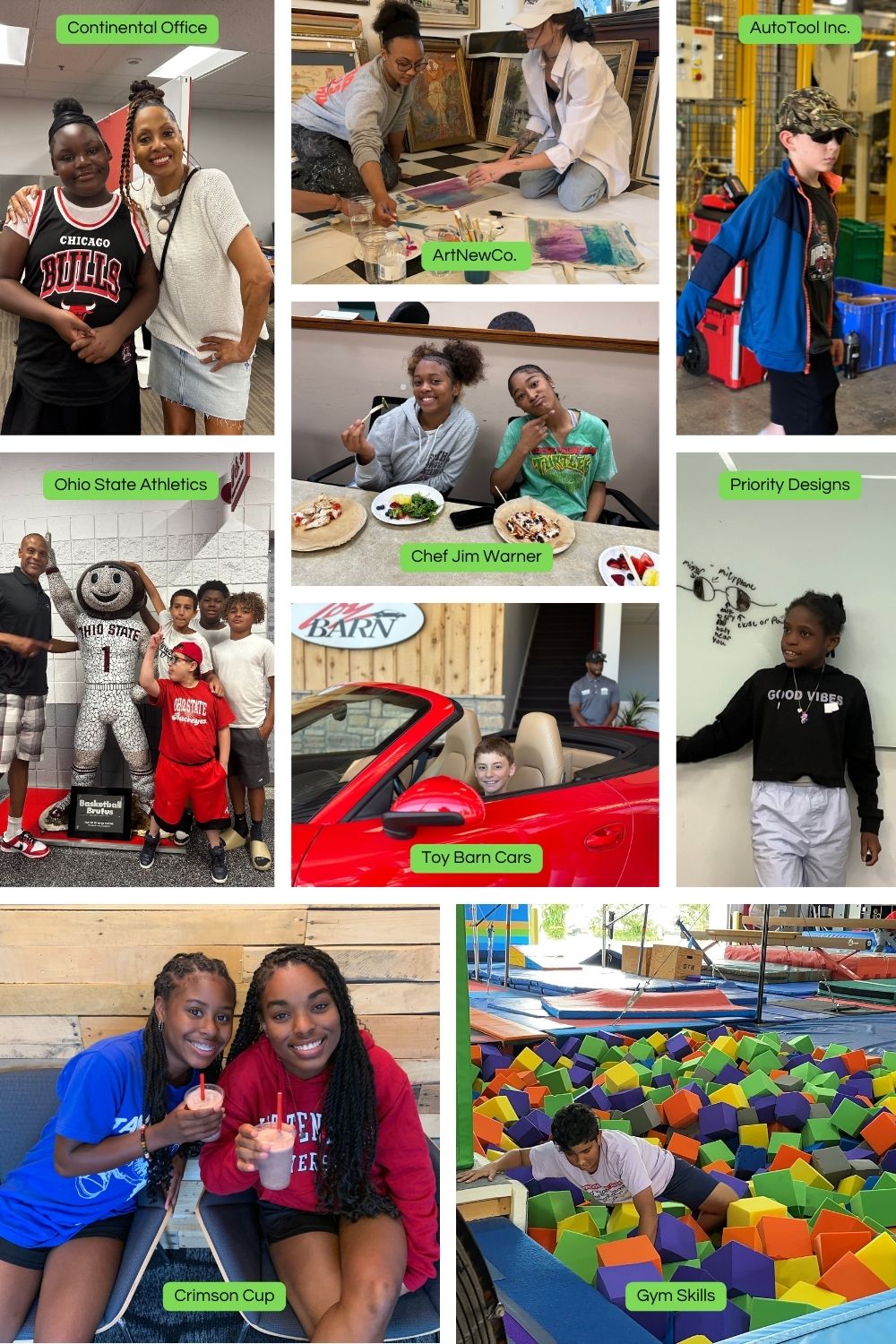
With limited space, I can’t highlight every one of our 40 business partners (and we need more!), but here are a few of them. First up is AutoTool Inc., an equipment and automation manufacturer. I’ve known Jason Moore, the CEO, for over forty years. He was one of the first white suburban kids here in Central Ohio to hoop, and hold his own, on an AAU team with black inner-city players. Well-spoken, well-dressed, and well-liked, he greets every teen by name at the front door. Jason provides a delicious lunch for the group, gives them a tour of the facility, and allows participants to ask lots of thought-provoking questions. Kim Bodrick is a client-experience manager at Continental Office, which offers full-service solutions for commercial interiors. Kim’s lively personality and friendly demeanor eases participants’ fears, who initially, aren’t quite sure what the experience will entail. After a brief tour of office space layouts to gain inspiration, the youth are placed in their respective teams. While competing in Kim’s Designer Challenge Game, disinterest vanishes and creativity picks up as the vulnerable teens design their office space masterpieces. Each team presents their finished project to the entire group, with bragging rights and prizes up for grabs. This two-hour field trip goes by so fast!
One of our newest partners is ArtNewCo., a whimsical vintage art boutique owned by entrepreneur and art lover Hannah Gleason. With over 800 pieces of rare vintage art and jewelry, ArtNewCo. offers a range of affordable price-points for even the most cost-conscious customers. Hannah invited our group into her studio this summer for a painting activity It was a life-changing experience for many of our teens, in some cases, doubling as a therapy session to move beyond their pain. For that 75-minute window, they didn’t have a care in the world. Musicians were also brought in, a keyboardist and violinist, for biochemical-boosting and circadian-rhythm purposes. Last but certainly not least is The Columbus Foundation, one of the top 10 community foundations in the United States, serving thousands of individuals, families, and businesses with their unique funds and planned giving efforts. Hosted by Steve Moore, Chief of Staff at The Columbus Foundation, he shares with our teens what philanthropy is, why it’s important, and how they can even become philanthropists right now using their time (as community volunteers) and talents (as peer-to-peer mentors). Of course, receivers should at some point transition to givers; the countdown is on. Click the link below to view a comprehensive list with background information on LFYO’s 40 Business Partners:
2025
LFYO Community Partners
Click the link below to view the full list of our community partners.


In closing, here’s how you help under-resourced youth dream big in spite of their current challenges or past failures. First, take the time to understand the roots and offshoots of generational poverty from an empathy-assimilation point of view. Place your physiological self in their physical shoes. The complexities of economic distress are multifaceted and cannot be reduced to a simple explanation. Its branches extend far and wide, including but not limited to structural barriers, psychological disorders, physical disabilities, societal biases, nutritional deficiencies, relational hardships, educational setbacks, and spiritual hangups. Second, assist high-need students in compiling an ownership checklist of synonyms and catchphrases that clarify and crystallize what it means to dream big. Among others, they include “thinking outside the box,” “challenging the status quo,” “defying the odds,” “chasing limitless possibilities,” “reaching for the stars,” “aiming high,” “setting bodacious goals,” “having a driving ambition,” “thinking big and bold,” “aspiring for great things,” and my favorite, “never settling for less” when more is available. More progress. More success. More happiness. What is an ownership checklist? This to-do list or schedule of activities can place students in the driver’s seat, where they’re in control of their respective dream — as they imagine it. In effect, this list holds students accountable for their growth gains in thought, word, and deed. Third, provide vulnerable youth with unforgettable field trips and life-changing experiences that can enlarge their possibility filter. In this article, I’ve shared a working template that you can follow or modify to your satisfaction. Let’s move out so they can move up!
Letters from LFYO Business Partners
Ascend Advisory Group
Tony Reilly
CEO
Hamilton Parker
Laura Wagner
Director of Human Resources
Schottenstein Real Estate Group
Kerri Ward
Director of Corporate Marketing & Communications
This is a very long headline to turn your visitors into users
Change the color to match your brand or vision, add your logo, choose the perfect layout, modify menu settings and more.
Short headline
Change the color to match your brand or vision, add your logo, choose the perfect layout, modify menu settings and more.
2025 Fundraising Luncheon Email and Social Media Blast #2
The LFYO Fundraising Luncheon Is Just Over Two Weeks Away

Let’s Talk for Real as Our Children Head Back to School: Why Do Inner-City Youth Struggle in Math and English Language Arts?
LFYO’s Business Partner in Focus

The road ahead for vulnerable youth is fraught with pitfalls, detours, and hazard signs; they just don’t know it yet. If they can’t “get math” early in life, then they’ll likely struggle financially later in life. And when underprivileged students are tripped up by the Queen’s English in childhood — failing to sell in to grammar excellence because they’re too worried about being labeled sell outs — this will often lead to economic setbacks in adulthood. Credit might be extended to them from an unscrupulous or even trustworthy financial institution, but will they read the terms and conditions that apply before signing on the dotted line? Probably not. Granted, their never-ending emotional crisis doesn’t provide them with any breathing room; the treadmill of generational poverty is missing a turnoff switch. There’s also a good chance they’ll find themselves on the wrong end of the compound interest stick, the one that is brutally painful to those being hit in the head by exorbitant fees (think payday loans and scarcity taxes) while members of the unbanked community. The arbiter of their cruel fate? Mr. Statistics. His firmness can be debilitating and fairness quite liberating when one’s socioeconomic status is under the microscope. That’s why it’s so important to help inner-city youth bend the odds of academic success in their statistical favor. For momentum’s sake, the earlier the better because time is truly running out for them.
Showing Up, Checking Out
There is a growing contingent of high-need students who are showing up to school but checking out on productive learning. In the fourth and fifth grade. Not good. Decades ago, at-risk youth would at the very least stay the course up to (and through) ninth or tenth grade. Few dropped out before this exhaustion checkpoint. And when school becomes a drain in our modern world for those on the fringes of society, minds began to drift as disinterest takes root. If you’re familiar with today’s version of urban education, the offshoots of academic drift are easy to spot. Blank stares. Heavy eyes. Incessant yawns. Slouched torsos. Indifferent demeanors. Pessimistic attitudes. Antagonistic behaviors. Lackluster efforts. Incomplete assignments. Perpetual excuses. The list of telltale signs is practically endless. Now, being present in the moment has its advantages when you’re focused on a current task at hand. However, it becomes problematic without any sense of urgency for your future wellbeing and personal growth. You know the drill: Those who fail to plan, plan to fail. Why? Because they rarely look ahead to connect the down-the-road, aspirational dots. It’s not entirely their fault of course, but many underprivileged students often make the mistake of living every second of each day for the moment. Without vision though, life becomes a meaningless voyage. Wasted opportunity, squandered potential. What a tragedy, and this is happening under our watch!
In 2024, LFYO’s annual theme centered on closing financial gaps across social class categories. This year, our focus is on bridging the fifth-grade academic divide through personal finance concepts and real-world applications that align with the Ohio Department of Education’s content standards for public and charter schools. So, what is our methodology to pull this off? Address the educational gaps by upgrading their mental maps. On the math side, among others, the following areas have been stumbling blocks for inner-city students in fifth grade: solving multistep algebraic equations; understanding and identifying place values as powers of 10 (whether moving to the right or left of the decimal sign); following the correct order of operations using the PEMDAS acronym; interpreting data and making logical inferences; and finally, working effectively with ratios, proportions, fractions, and percentages. On the English language arts side, vulnerable students generally struggle with compare and contrast details in a story; experience tremendous difficulty in determining the meaning of words and phrases as figures of speech (metaphors, similes, and idioms); and often fall short in writing critically and convincingly in a thoughtful manner.
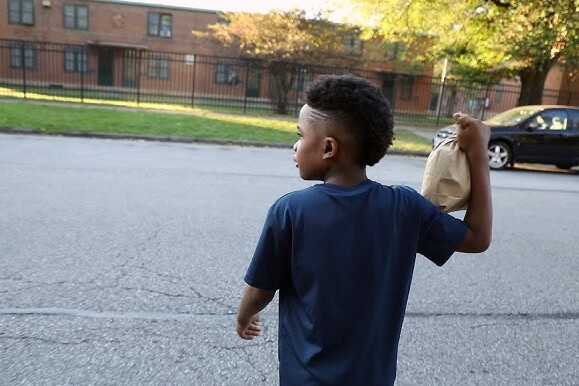
Up Close and Personal: What's Life Really Like in Poverty?
While working with at-risk students over the past 27 years, here are a few observations and explanations for their academic challenges. Both math and English language arts have clearly defined rules. In poverty, subjectivity rules the day, not objectivity. How someone feels is often more important than what’s factually true. Life is typically viewed from a gray lens, not a black-or-white prism. Obviously, an unstable mood has a spillover effect in the classroom and on standardized tests where it’s quite easy to jump to conclusions or take the path of least resistance. It’s my estimation that a disrupted and dysfunctional circadian rhythm system plays a huge role in the struggles of under-resourced students. Think about it. They often live in cramped, chaotic environments with lots of background noise in substandard conditions. Book reading is not prioritized, which contributes to their limited vocabulary and narrow conversation register (typically less than 750 words in their daily communication account). Meal time and bedtime are moving targets, which is why so many of these kids use school to catch up on lost sleep at their desks. Structure and order is often based on fear — as in who barks the loudest threats — or “do what I say without questioning how I live!” With limited finances, paying for tutoring services to close academic shortfalls is out of the question; the “extra money” just isn’t there. Lastly, the present takes precedence over the future. What’s out of sight is usually out of mind. (Although a gifted student academically, I did grow up on welfare in public housing for 18 years with three older sisters. “Ma Dukes” did the best she could to take care of four kids by herself, but poverty’s landscape is hard to navigate for a mom on a solo-parent mission.)
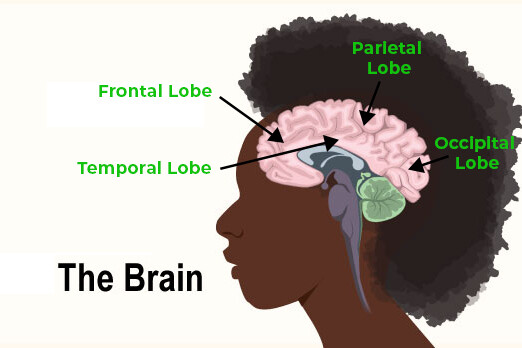
Let’s talk about the brain, a subject I love to discuss as a self-proclaimed neuroscience junkie. Nothing changes academically without an improvement here. I read a study years ago that shook me to the core. The brains of poor kids, middle class kids, and wealthy kids were evaluated based on their neuronal density in the cerebral cortex. Neuronal density is a measurement of targeted brain development. For middle class and affluent children, the findings showed no difference in the four lobes (frontal, parietal, temporal, and occipital). Aside from socioeconomic factors, no cognitive deficits existed between students from blue-collar homes and white-collar households. Their brains were on an even playing field. Poor kids on the other hand, they lacked neuronal density in two brain regions, the frontal and temporal lobes, by a whooping 10 percent! Known as the executive command center, the frontal lobe analyzes data, makes inferences, weighs consequences, regulates impulses, and silences “runaway” fears, among many other responsibilities. Wealthy communities place a huge emphasis on frontal lobe development, which is likely one of the main reasons why they send their children to elite private schools with hefty price tags. The temporal lobe is the hub for learning, remembering, communicating, believing, and balancing. As you’ve probably guessed, mathematical thinking is the domain of the frontal lobe. And English language arts primarily falls under the jurisprudence of the temporal lobe. In the poor kids, their hippocampus (think memory center) shrank while the amygdala (think deep-rooted emotions such as anxiety and fear) grew exponentially. It’s hard to learn when your brain is stuck in fight-flight-fright mode, even in a school-based setting with top-notch teachers. Not surprisingly, impoverished students missed the mark academically in the same brain regions with the most glaring deficits.
Neuroscience News
“The study [Poverty’s Most Insidious Damage: The Developing Brain] in JAMA Pediatrics, by a team of researchers at the University of Wisconsin-Madison, found that low-income children had irregular brain development and lower standardized test scores, with as much as an estimated 20 percent gap in achievement explained by developmental lags in the frontal and temporal lobes of the brain.”
Wrapping up, community partnerships with local businesses have been one of LFYO’s key value proposition drivers. In our current wheelhouse, we are incredibly grateful to have 30 companies that welcome LFYO kids into their establishments. Of course, we need more. In my next article, I’ll discuss how you or your organization can join the LFYO Business Partner Team. For over a decade, Toy Barn Cars and owner Shawn Cunix have provided our at-risk youth with an unforgettable experience (which is the main reason why I buy all of my vehicles from this dealership.) Underprivileged tweens and teens are treated like VIP customers. They even get a chance to sit and take pictures in their six-figure dream cars! What’s more important is the information these young people receive while on the field trip. And yes, all roads point back to reading, writing, and arithmetic. General manager Chris Scott often shares with the group, “A credit score is like your report card.” He adds, “When you have a great credit score, like an impressive report card, a lot of opportunity doors open that would normally stay closed. Make sense?” Scott understands that when you have a captive audience with lives and legacies hanging in the balance, your words of wisdom must resonate with their way of thinking. That’s why LFYO is teaming up with Toy Barn Cars and other Central Ohio businesses to create an app-based financial life skills curriculum that aligns with state academic standards and vulnerable students’ interests. What’s relevant inside and outside a classroom will have a great chance of clicking with disadvantaged children who need every incentive to move forward in life. The investment — however large — is worth it. (To read Shawn Cunix’s incredible story as an entrepreneur and philanthropist, please click the link below.
References
The impact of child poverty on brain development: does money matter?
EEGs show brain differences between poor and rich kids
2025 Fundraising Luncheon Email and Social Media Blast
2025 LFYO Fundraising Luncheon Is Right Around the Corner

The 2025 LFYO Fundraising Luncheon is one month away. We will be celebrating 27 years of service as a nonprofit, having offered empowerment-based initiatives to over 30,000 participants in every inner-city community here in Central Ohio. Our mission is straightforward: To improve the life prospects and legacy pathways of vulnerable populations through targeted programming in the following areas: financial (and nutritional) wellness, physical fitness, personal branding, educational excellence, college and career readiness, mentoring support and life coaching, social and emotional learning (SEL), and brain development exercises for children with developmental disabilities.
In sports, setting the tone for success early in the game improves a team’s chances of achieving a favorable outcome when it ends. That “early start” can segue into sustained, positive momentum throughout the season. What happens when at-risk populations struggle in the first quarter of life? They often scramble to play catch up, swinging for the fences with get-rich-quick schemes to combat poverty’s plight (like playing the lottery), throwing hail Mary bombs down the field when dealing with crash-out meltdowns (to tackle unresolved trauma), or taking long-distance threes, really ill-advised shots, instead of making two-point layups as the opportunity clock winds down (given their limited options at play). As time moves on however, the compounding effects of life quarter mishaps create an even deeper scoring deficit for disadvantaged Americans and their unsuspecting offspring in the process.
At our fundraising event on September 12th, we’ll revisit these sports-based themes by asking a simple question: How can we create a winning game plan that allows every person to succeed on the field of opportunity? In our classrooms. Within our companies. Through our civilities. Keynote speaker and OSU coaching legend, Jim Tressel, will share insights on how those in attendance can make a lasting difference in the lives and legacies of those on the fringes of society. No matter how we vote, where we work, or who we are, the mission is clear. Until the least among us is given the best chance to shine — with a hand-up and not a handout — we can never be satisfied with the current state of affairs. Gaps are getting wider in every area, which means more bridge-builders need to step up. That would be you, me, us.
Take a look at the event details for our fundraising luncheon on September 12th:
First-Half Lineup
11:30 AM — 12:30 PM
Registration, Networking, Hors D’Oeuvres, and Silent Auction
Second-Half Lineup
12:30 PM — 1:30 PM
Lunch, Program Opening Remarks, Guest Speakers, and Closing Comments
Master of Ceremonies: Ahmaad Crump, Cleveland Cavaliers In-Arena Host and Crowd Hype Man

We will have 12 spectacular auction-item packages to bid on. Yes, exclusive packages. Here are a few of them …
Silent Auction Item #1
OSU Basketball Dream Experience
Four-course dinner for 3 with former Ohio State player Lawrence Funderburke before the game at a five-star restaurant, 3 tickets behind the OSU bench to watch the Buckeyes against a top-tier opponent, group picture on the basketball court and a private tour of the locker room after the game, followed by a meet-and-greet with players and coaches. Go Bucks!
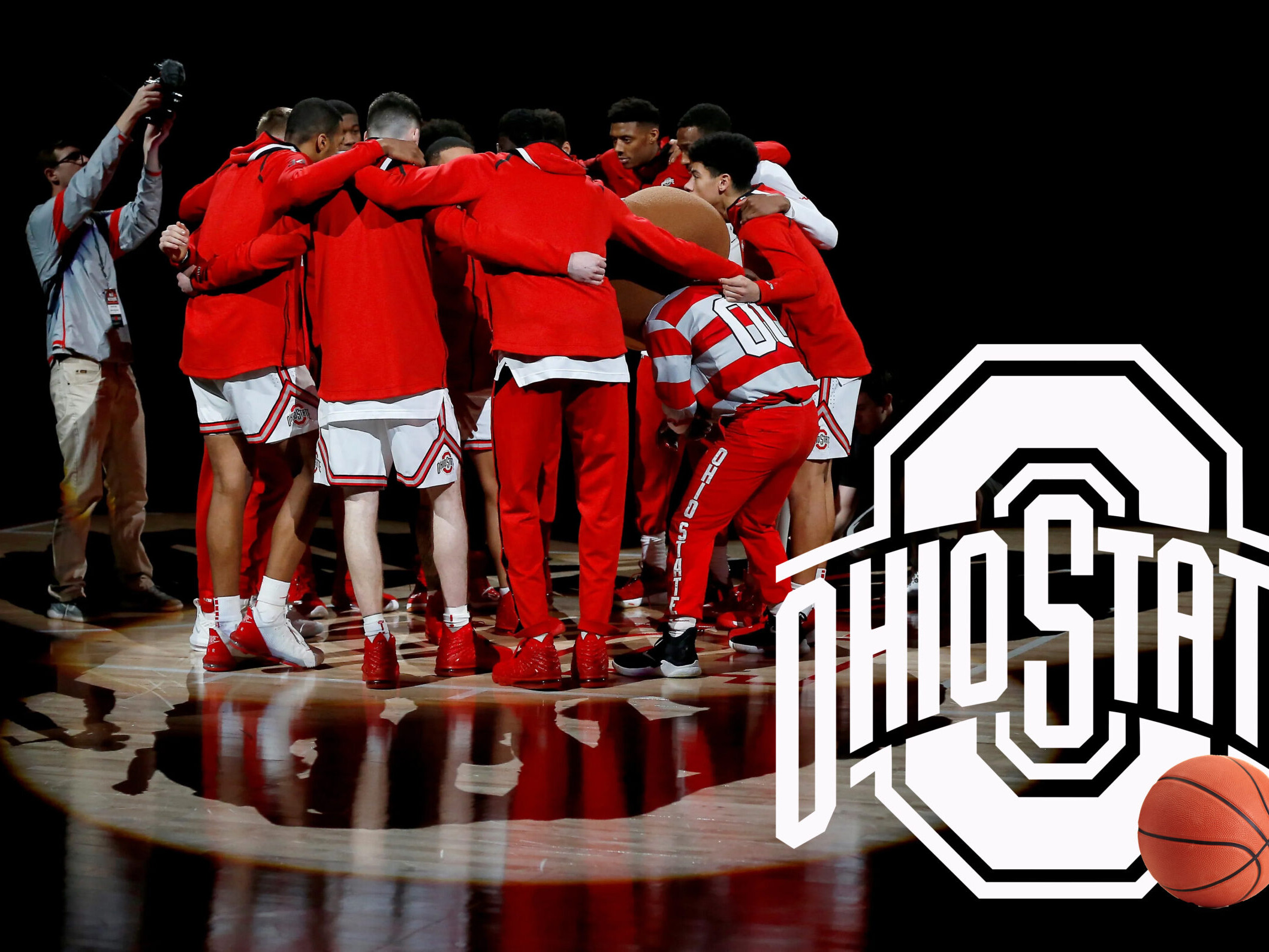
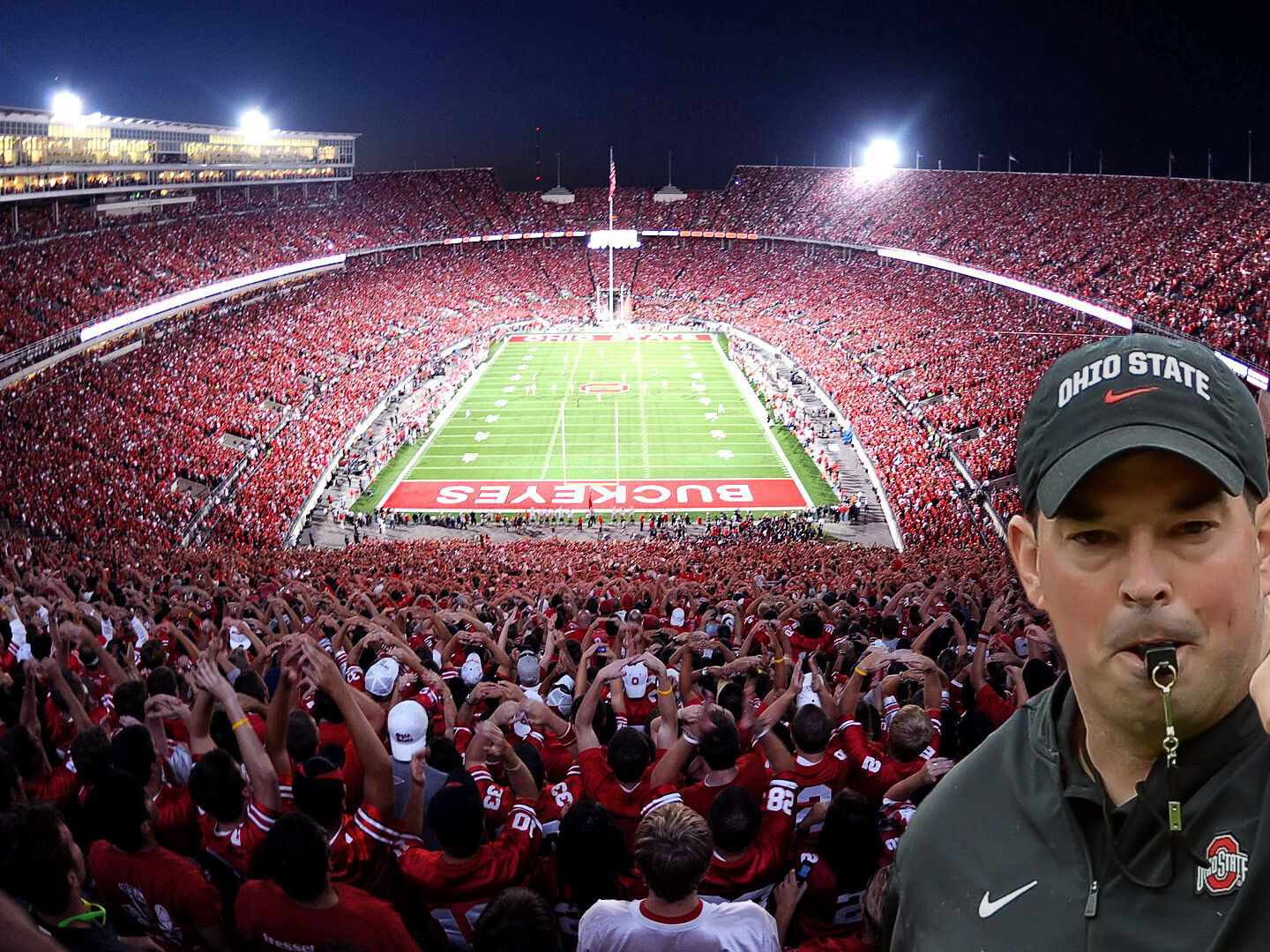
Silent Auction Item #2
OSU Gridiron Package in the Shoe
O-H … I-O. Watch the defending national champions play Minnesota at home on October 4, 2025. Noteworthy package includes 4 Fisher Pregame Brunches three hours before tipoff, 4 premium lower-bowl tickets, and an autographed football by former and current Buckeye star players.
Silent Auction Item #3
Fine-Dining Experience with a Super Chef
Enjoy dinner for 8 at your private residence with Chef Jim Warner, a renowned culinary specialist for professional athletes, esteemed dignitaries, and high-profile CEOs. This unforgettable experience includes a delectable five-course meal that is sure to satisfy the eyes and palates of your awestruck guests. Bon appetit!

Lastly, I want to give a special shout-out to our amazing sponsors …
2025 LFYO Fundraising Luncheon Sponsors

Legacy Sponsors
- Maggie and Tom Fleming
- Franklin County Board of Commissioners

Hall of Fame Sponsor
- The Robert Weiler Company

All-Star Sponsors
- Anonymous Sponsor
- Thompson Concrete
- Rebecca and Brandon McAllister
- Advanced Civil Design
- Michelle Moore and David Houze
- Linda and Roger Blackwell
- Monya and Lawrence Funderburke
- Lindsey and Jacob Osborn
- Daniel Levitt
- Ascend Advisory Group

Superstar Sponsors
- Schottenstein Realty Group
- Uckele Nutrition
- Rich Russo Realty
- Autotool Inc.
- Lynnda Maria Davis
- Abby and Andrew Crum
- First Merchants Bank
- Good Nature
- Muskingum County Community Foundation
- Jim Frey Real Estate Advisors, LLC
- Dee Miller (State Farm)
- Jim Haring
- Andrea Oyanadel and Friends
- Buckeye Bank
- Donatos Pizza
- Crimson Cup
- Adam Lewin Foundation/Hamilton Parker
- Aurora Exhibits
LFYO 2025 Summer Programs

LFYO has teamed up with the GoodLife Foundation and Gladden Community House to present seven weeks of summer programming for area youth. For vulnerable populations, it’s critical to offer positive outlets to combat their often negative outlooks. One thing is certain: We must keep our kids safe and out of harm’s way, just as warmer days tend to lead to more community violence. Financial life skills not only improve favorable outcomes for at-risk youth, but they also serve as violence prevention measures. You see, the biggest difference between disadvantaged teens and their well-to-do peers comes down to opportunity. Highly successful careers are par for the course in affluent (and even upper middle class) communities. And this is why their children have a distinct advantage. That’s why LFYO serves as a bridge-building specialist to help level the playing field without settling a score. By leveraging the three E’s of success, this can help close the opportunity gap. Exposure. Experience. Expectation. Expose underserved youth to what can be, provide the life-transforming experience to achieve it, and watch what happens. The expectation to do better feeds itself when they’re fed a smorgasbord of real-world opportunities (which is a beautiful thing to behold when at-risk youth who once felt disempowered now value empowerment). This is how we change lives and transform legacies, one broken spirit and battered soul at a time.
Destiny is something you can’t run from or bump into by accident. Either you’ll fulfill it or let it waste away.
Over the past four weeks, we’ve taught underserved youth how to create (and protect) their personal brand, identify their unique wiring fit, and gain much-needed financial life skills. Heavy concepts indeed for teens and tweens to grasp. But young people can learn anything if it’s memorable, manageable, and marketable to their way of thinking. What’s memorable draws upon hope. What’s manageable provides the help. And what’s marketable fuels the hype, or what it takes to get them fired up about their promising future. Chris Scott, general manager at Toy Barn Cars, commented, “The group of kids you brought in for a tour last month were very impressive. They asked great questions, which is a sign that they’re serious about their future!” Jennifer Griffith, market president of First Merchants Bank, shared, “Your kids came up with some really clever ideas in the Shark Tank simulation game during their visit to the bank.” She added, “And many of them seemed to overcome their fears of public speaking, which is tough for adults let alone children to do.” It’s not a capability issue with our most vulnerable youth; it’s an accessibility problem. When they’re armed with an upgraded vision and a rock-solid value proposition, their upside is limitless. Take a look at the pictures, videos, and lineup of LFYO’s summer activities thus far …
Hope
The measures employed by LFYO to assist at-risk youth in fine-tuning their faith lens while in pursuit of a promising future.
Help
The means offered by LFYO to empower vulnerable populations through life-changing experiences and cutting-edge programs.
Hype
The methods used by LFYO to get inner-city youth fired up about their future opportunities as well as the work involved.
Video Highlights
Please take a moment to view a brief video highlighting some of the key moments from our initial meetings with the participants.
2025 Fundraising Luncheon
The 2025 LFYO Fundraising Luncheon is just around the corner. It will be held once again at Hyde Park Prime Steakhouse (Downtown). The date? September 12th. The time? 11:30 AM to 1:30 PM. The cause? To raise investment support for LFYO programs. The offering? A first-class experience at a five-star dining establishment while mixing and mingling with some of Central Ohio’s most prominent and influential people. The crowd? Business leaders, former Ohio State coaching legend Jim Tressel and other Buckeye greats as well as philanthropic-minded individuals (like yourself) will be in attendance. To date, we have almost 30 committed sponsors — a record. If you or your organization is interested in sponsoring or attending the event, please email me at info@MrFundy.com. Couples and individuals with an interest in attending the 2025 LFYO Fundraising Luncheon will be placed on a waiting list due to limited seating of 140 attendees. First preference is given to sponsors and their guests. For more details on the event, please click the button below.
The Location
Hyde Park Prime Steakhouse (Downtown)
The Time
11:30 AM to 1:30 PM
The Offering
A first-class experience at a five-star dining establishment while mixing and mingling with some of Central Ohio’s most prominent and influential people.

The Date
September 12, 2025
The Cause
To raise investment support for LFYO programs.
The Crowd
Business leaders, former Ohio State and ex-professional athletes, and philanthropic-minded individuals (like yourself) will be in attendance.
In closing, we want to once again acknowledge our 2024 and 2025 Legacy Sponsor, Maggie and Tom Fleming. Their generous contributions have allowed LFYO to purchase more than 30 iPads with bluetooth keyboards and protective cases as well as offer programs free of charge to hundreds of inner-city youth. To the Flemings — and every LFYO investment supporter! — thank you for helping us carve out our unique niche in changing lives and transforming legacies here in Central Ohio and beyond.
Upstream Problem, Downstream Playbook (Part Four)
Hype fizzles and hope fades without the help. To whom much is given, much more is required. And when you see a need and don’t fulfill it — ardent capitalists, I’m speaking to you! — a lot of innocent people get hurt (and left behind) in the process. Now, capitalism gets a bad rap when certain segments of society who have less begrudge, and sometimes berate, those who have a whole lot more. Obviously, it’s nearly impossible to move up the socioeconomic ladder when you have tremendous disdain or utter contempt for those who’ve legitimately climbed to the top of it. These ladder climbers have worked hard, played by the rules, and taken the necessary risks to generate wealth. No harm, but why are they being called for a foul? Without question, capitalism has its fair share of embedded flaws, and they’re too numerous to cover in this article. But this flawed system is still the best option we have among competing alternatives, notably socialism, collectivism, marxism, egalitarianism, and transhumanism. Without access to capital, it’s easy, really quite natural, to take issue with the excesses of capitalism.
I get it. Equal opportunities do not always translate into equitable outcomes. This is where the haters of capitalism miss the mark, demanding that the government step in and legislate social outcomes based solely from the lens of economic justice. Serving as the de facto referee to mitigate wealth inequalities is a slippery slope for any governmental agency to oversee. In sports, the best referees are those who aren’t noticed, no matter where the game is being played — at home or on the road. They intervene only when the “right call” requires it, independent of the background noise. As a compassionate capitalist myself, we’re free to earn a great living individually or entrepreneurially, so long as we’re good stewards of the planet while empowering the least among us in lockstep with our money-making endeavors. Arms-length donors are good, where high net worth individuals and families write sizable checks to charitable organizations. However, in-person philanthropists are best. They’re not afraid to fund worthwhile causes and embrace sociophilanthropy, where mega-affluent Americans reach and teach the less fortunate, on their court, how to build legacy wealth. One income stream or investment asset at a time.

An Opportunity (and Free Meal!) Too Good to Pass Up
I enjoy being in the presence of really smart people who are also extremely successful, even if we disagree politically or philosophically. Nearly two decades ago, I had the pleasure of meeting former New York City mayor, Rudy Giuliani. He was in town to discuss a sizable investment in the Central Ohio market with a group of business leaders, a who’s who consortium of power brokers across the Midwest and East Coast. I was sitting in the lobby at the New Albany Country Club. Walking by, Mayor Giuliani found out who I was and asked, “Would you like to join us for lunch?” I responded, “Absolutely!” The look on some of his colleagues’ faces, all white men except me, said it all. “Why is he being invited in our group? He’s clearly not one of us.” I wasn’t, but that didn’t stop me from being present and making my presence felt that afternoon (as I usually do in settings where I stick out like a sore thumb). As the lunch meeting wrapped up, Mayor Giuliani turned and asked me, “Lawrence, would you like to share anything?” The grin on my face was from ear to ear. I enthusiastically replied, “Sir, I do have something to add, actually two questions to ask.” I continued, “Gentlemen, we’re talking about the economics of construction projects, right?” They nodded in agreement. “But what are we doing to bridge the wealth gap in our society between the haves and have-nots?” No one, not even Mayor Giuliani, had a response to this question — just blank stares and personal reflections. Yes, the “troublemaker” was in the building.

Making Waves So That Every Opportunity Boat Can Rise
Sounds harsh to the sensitive types, but this jaw-dropping quote by Dr. Phil is heartbreaking. On the financial front, think about the ramifications this has for taxpayers (in the hundreds of billions of dollars each year) who have to foot the bill when millions of unsuspecting Americans move from childhood to adulthood without being properly educated. The result? Prison populations and welfare rolls swell up even more. We are setting our most vulnerable kids up for failure down the road if we do not intervene before these students reach middle school. And high school is way too late! This is why a downstream playbook is needed to combat an upstream problem, one in which poorly performing students don’t even know they’ll face in the future. Remember my emphasis on the alpha brain wave state in the first three articles of this series? Watch this. Between the ages of 9 and 12, third through sixth grade, children start questioning their view of reality. “Hey, wait a minute — this doesn’t make any sense!” They also find out that the Easter Bunny, Tooth Fairy, and Santa Claus aren’t real, which captured their imagination in the fantasy world state of theta wave frequencies (or the two to six age range). My apologies for being Ebenezer Scrooge in breaking this news 🙂
During the alpha brain wave state, kids are still receptive or open to new information. This is the sweet spot of personal growth and financial education downloads, where children are forming their beliefs and shaping their values, among over 100 other areas of brain development. In general, here’s what is taking place in young minds when alpha wave frequencies are in overdrive mode throughout their waking hours: They’re making estimations and drawing conclusions about what is (or isn’t) possible in life from a macro or big-picture perspective. In other words, young people are making decisions about what opportunities they do or don’t want to weigh on the scales of possibility. Literally, they will talk themselves into or out of a faith commitment with life-altering future consequences. Now, most youth won’t likely know their career path at this time — becoming a lawyer, teacher, trainer, truck driver, fashion designer, computer programmer, or business owner, among other noteworthy professions — but they’ll have a pretty good idea whether they’re game for embracing or avoiding the workload to achieve a successful life. That’s why fifth grade is the perfect time to introduce at-risk students to getting a job, earning a paycheck, managing a household, building good credit, and investing in stocks. The further ahead they can see, the less distracted underprivileged youth will be — right now when neuronal connections are expanding. Their life scripts and self-talk filters are being set in motion during this pivotal age range.

Right Foundation Laid, Success Bridge Built
Our three bridge-building pillars to improve the educational outcomes for at-risk students include financial preparedness, physical fitness, and nutritional wellness. Lessons learned early in life can prevent costly problems later in life. Whether it’s an abbreviated or extended program for inner-city schools, we start with money. Our signature game, Reality Days, helps students see the correlation between post-secondary education and lifetime earnings. Now, college isn’t for everyone but some type of education is mandatory, even if it’s an apprenticeship for a skilled trade. For higher-income earning game participants, they gripe (okay, complain) about paying more taxes than their lower-income counterparts. Enter a riveting discussion on our progressive tax code. Assumptions are made, given that each player is presumed to be a married, seasoned adult and primary breadwinner. Some of the game participants have children to take care of, others do not. Food, clothing, and childcare quickly add up, causing several students to blurt out, “I ain’t having no kids; they’re too expensive!” To which I’ll reply, “Children are a blessing. But parents shouldn’t bring a child into this world until they’re mentally prepared and financially ready for the responsibility.” Although this insight is anecdotal, many past LFYO participants have avoided unplanned pregnancies (as teenagers) after taking part in one of our programs. In some small way — perhaps due to emotive association — I suspect this real-world game may have influenced their thought process to delay an untimed pregnancy. I also share with every group that middle-to-high-income caregivers, on average, will spend between $150,000 to $300,000 from birth to age 17 for each child. That’s right, per kid! Of course, this does not include college expenses.

When the body moves, the brain improves. That’s why physical fitness is so important to our educational mission. Those of us who are over 50 can remember the time in grammar school when gym class and two recesses were the daily rule, not the weekly exception. And standardized test scores have been plummeting ever since physical education was devalued in the late 1990s and early 2000s, especially for our ants-in-their-pants boys (who should be moving more outside and sitting less inside). Is it an ADHD problem or an NATD issue, as in a “no activity today disaster”? That sugared-up energy boost from an artificially sweetened breakfast or calorie-packed, nutrient-deficient lunch has to be expended somehow. In some districts around the country, kids barely move, outside of walking from one classroom to the next. Activity levels are way down across the board, while obesity rates and poor health outcomes have skyrocketed. Fewer kids competing in after-school activities mean more time playing video games, watching mind-numbing TV, or surfing the internet when they go home. In fairness, working-class parents may not have the time, money, or transportation to get their children involved in a sports-based program after school. We incorporate balancing exercises, tug-of-war games, and agility drills into our physical fitness routine. Students also learn how to stretch and breath properly. They even get a chance to play me one-on-one in basketball! What kids don’t know is that every activity is designed to improve a specific area of their brain, belly, or body. (We are cognizant of the fact that some kids have major anxiety around their weight. Thus, we do take measures — without letting them be excused from participating — to ease their fears due to embarrassment.)

Hacking Their Own Biochemical Code: It’s More Art Than Science
Perhaps the biggest benefit for high-need populations who take part in our program is this: we teach them how to hack their own biochemistry through practical and tactical, sensory-driven approaches. When they wake up in the morning, or look to the future, vulnerable students are stimulating glutamate receptors in the retina. This neurotransmitter provides visual, mental, and emotional stimulation to tackle each day’s demands. And food, what they eat nutritionally and consume inspirationally, will play a huge role in their upgraded olfactory and gustatory systems. Yes, success has a sweet-smelling aroma and flavorful profile to those who’ve faced a great deal of bitterness in life. Tasting success is not a figment of one’s imagination. In fact, it’s hardwired into mammalian taste buds. In addition to glutamate, other neurotransmitters on the tongue include serotonin (think sublime joy), norepinephrine (think intense concentration), acetylcholine (think muscle memory), GABA (think unshakable peace), and adenosine triphosphate or ATP (think cellular energy). It hasn’t been confirmed by researchers yet, but I have a sneaky suspicion that endorphins — think pain relievers and self-esteem boosters — may also be part of the taste bud apparatus. We do know that spicy foods boost endorphin levels with regularity. (This may explain why food scientists, aka neurotransmitter manipulators, place addictive ingredients in cakes, cookies, pastas, potato chips, French fries, hamburgers, and other American delicacies that elicit euphoric emotions in the bellies of satisfied customers.)
Biochemical wholeness is heavily reliant upon nutritional wellness, especially when it comes to regulating the autonomic nervous system (which consists of the sympathetic and parasympathetic nervous systems). Sympathetic dominance is par for the course in generational poverty, where financial hardships, toxic thoughts, and poor eating habits wreak havoc on depleted, stressed-out bodies. Turning down the sympathetic system’s emergency alarm bells and tuning into the parasympathetic system’s relaxation station is critical for emotional stability that can segue into personal growth. We provide healthy snacks — with organic ingredients — to students every session. The awards ceremony includes a certificate of achievement, $50 custodial savings account, share of publicly traded stock, and mentoring playbook poster for each participant. There’s more! Plus, a live cooking demo with Chef Jim Warner closes out the program in style. High-need populations deserve a first-class experience, complete with return-on-investment (ROI) expectations that can excite their success palates. For better life prospects and legacy projections.

In summary, it is only fitting for me to pay tribute to one of my mentors, a man who has been candid about his triumphs and trials throughout life, including being incarcerated for several years in the 2000s. Meet Dr. Roger D. Blackwell, a bestselling author and former business marketing professor of mine at Ohio State. I credit him a great deal for helping me incorporate personal branding as a key tenet of The Mr. Fundy’s Financial Life Skills for Youth Mentoring Initiative. It’s a theme that I emphasize in every empowerment class or workshop that we present to low-to-moderate income (LMI) communities. In his book Objective Prosperity, which Professor Blackwell co-authored with Dr. Roger A. Bailey, the birth lottery is highlighted. In short, the true currency of excess for the seniority class is their access. To more opportunities. To more options. To more opinions (from seasoned professionals who offer priceless advice). Children of wealthy parents have more access to goods and services than do their scarcity- or security-class peers. In baseball terminology, this is akin to someone being born on third base, also known as financial privilege. The authors note, “But here is a secret that [wealthy] people learn: It is better to have parents that give you values that help you to become prosperous than parents who give you money or capital.” Let that sink in for a moment. For at-risk populations and vulnerable students, financial values are what drive and define the meaning behind (or in front of) the money they’ll eventually earn and hopefully grow when hype, hope, and help are in ample supply. Let’s do our part in bridging the wealth gap in America.

Brain Coaching
If you’re interested in brain coaching for your individual or organizational needs, please reach out to Lawrence Funderburke by email at info@Mr Fundy.com. Thank you.
Books
Purchase Books
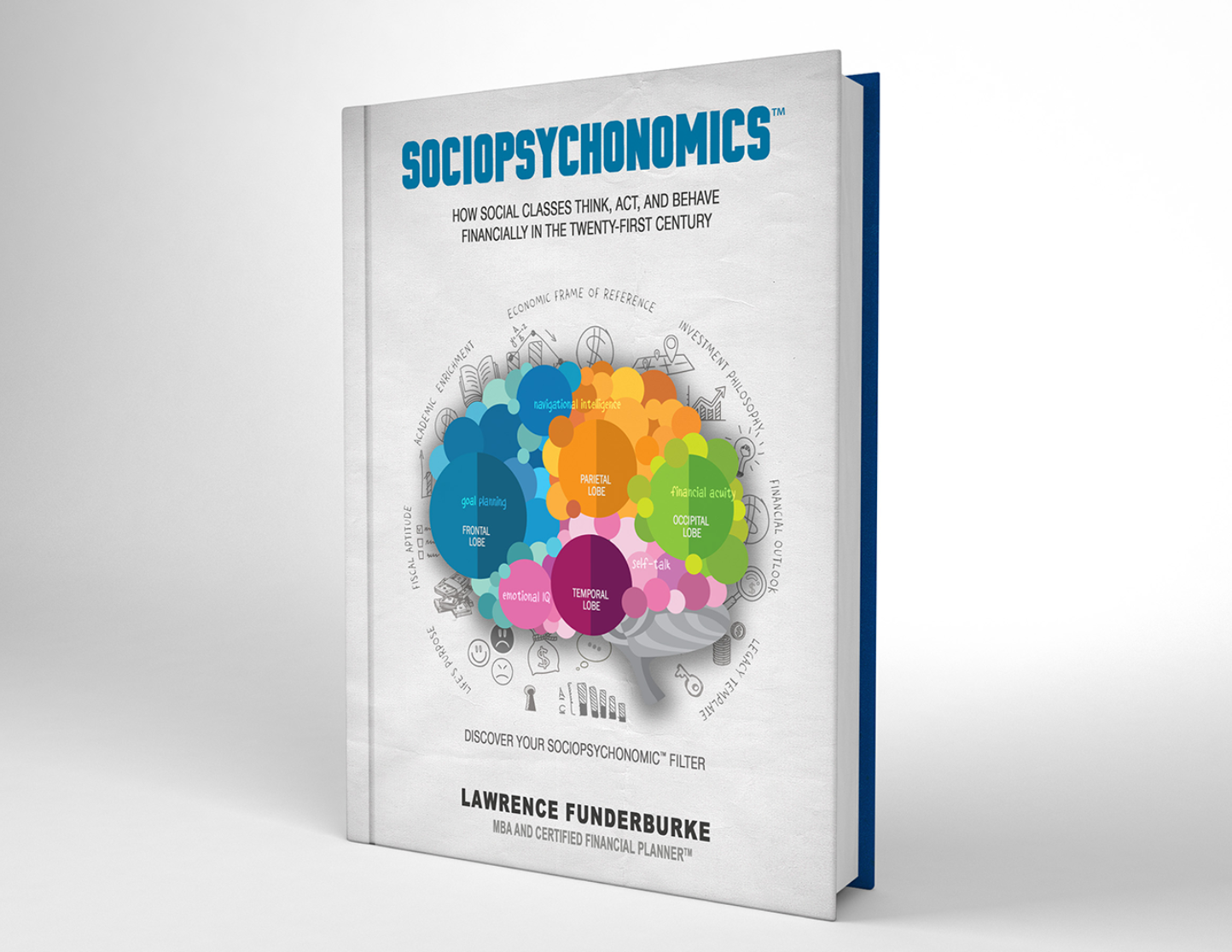
For more information on Sociopsychonomics, please click the link below.
Event
2025 LFYO Fundraising Luncheon

Click the button below for details on our upcoming fundraising event and our keynote speaker, Jim Tressel, former OSU football coaching legend and current Ohio lieutenant governor.
Recent Articles
Upstream Problem, Downstream Playbook (Part Three)
Hype first, then comes the hope. This word has many noteworthy synonyms, including a longing, yearning, urging, aspiring, or wanting for something better and brighter. A better opinion. A better option. A better opportunity. A brighter day. A brighter future. A brighter outcome. And financial education can provide a ray of hope to those who are stuck or stranded, sometimes through no fault of their own, at the bottom rung of the socioeconomic ladder. Miss the mark here with high-need populations, and they might not ever take the chance of climbing out of their economic hellhole. For those of you who have a disdain for (or distrust of) organized religion, please keep reading. This is an illustrative example, not a proselytizing sermon. Hope can’t survive without faith. In fact, hope and faith, along with vision, are inseparable tenets but not interchangeable terms. Hope expects (where both greatness and excellence lead the way in a purposeful life); faith believes (when the odds of success seem insurmountable or unattainable); and vision imagines (what could be in spite of how bad things have been). We’re told in Romans 11:1, “Faith is the substance of things hoped for, the evidence of things not yet seen.” This famous Bible verse has spiritual and practical applications. Why? Because life can’t be lived — eternally or internally — without some measure of faith-inspired and vision-guided hope. Literally and figuratively, it can push or propel those who’ve been beaten down by life across the financial success finish line. Here’s the problem for most of them: Hope is in shorter supply than money.

Rydell Gibson, a mentor and close friend of mine from Sacramento, shared these two faith acronyms with me over 20 years ago. Obviously, I’ve never forgotten them, nor his prophetic declaration over my life back when I played with the Sacramento Kings. He told me, “Lawrence, your assignment in life will be to instill hope into the hopeless.” He added, “You have the rare gift of helping people see their future lives from a present lens.” As I write this article, tears are swelling up in my eyes. I didn’t quite understand what Rydell meant back then, but I clearly do now. In his F.A.I.T.H acronym, “for all individuals there’s hope,” the key word is all. Everyone needs hope to express a given level of faith. Without it, life becomes a meaningless activity or uninspiring voyage. Here’s what I’ve learned while working with (and being a former member of) the scarcity class. Hope deprived is hype denied. Hype runs out of gas — to achieve better and brighter economic outcomes — when hope is missing from the picture. That’s why it is incredibly dangerous to get at-risk communities fired up about a financial future that can’t be seen or experienced up close and personal. This is the classic case of a gimmick trap, which was highlighted in the previous article. Gassed up, with no place to go. The result? Another letdown, and potential meltdown, is added to their disappointment ledger account, as lives and legacies hang in the balance.

If you’re in a leadership position — personally, parentally, pastorally, professionally, or philanthropically — I would highly encourage you to do (if you haven’t already) a comprehensive study into the cerebellum. What the mind expresses, the body experiences. Through the cerebellum. It’s located below the occipital lobe and behind the temporal lobe. Among other functions, the cerebellum coordinates the motor system, notably balance, coordination, and posture. It is also faced with the task of error prediction as well as overseeing (or being overrun by) fear responses. And when trauma gets trapped or stored in the body, the mind follows rather than leads. According to renowned psychiatrist and celebrity brain coach, Dr. Daniel Amen, “doubt shuts down the cerebellum,” as in not being able to operate or perform in an efficient manner. What’s fascinating about this area is that it occupies roughly 10 percent of the brain’s volume but requires 50 to 80 percent of the neurons. But for some reason, the cerebellum doesn’t garner a lot of attention. One more point: a doubt-ridden mind, hope’s antithesis, produces a deflated body and defeated soul. Did you get that? Let’s look at some real-world examples of doubt’s effects on the brain, belly, and body.

Enough of the technical stuff. Inside and outside the world of sports, I’ve witnessed collective doubt firsthand for over three decades. It can negatively impact a family, work group, classroom, community, or even basketball team. Duke Blue Devil fans, I’m not picking on your legendary program. But I’m still a bit shocked by your team’s epic loss to the Houston Cougars in the 2025 NCAA Final Four Tournament. Like most viewers, I assumed the game was over and Duke would win comfortably. I turned the TV off when the Blue Devils were up by six with about a minute to go in the game, and with a chance to extend their lead by eight points. “No way they’re gonna lose,” I thought. “Game over.” I didn’t know Duke had lost the game until I returned home from church the next day and my son Eli blurted out as I walked through the door, “Dad, did you know Houston beat Duke, 70-67?” I replied, “Bad joke son. Try again.” He was telling the truth.
For the next hour, I watched dozens of replays of the last few minutes of the game. Missed free throws. Questionable inbound passes. Careless, unforced turnovers. A short-arm shot — at close range — by college basketball’s best player. So what happened to the Blue Devils? As doubt crept in, player struggles picked up. Like clockwork, body language matched, really synced up with, the mental state of Duke’s players. And as the error predictor, their individual cerebellums mirrored what their collective minds expressed. Fearful thoughts (“What if we lose this game?”) Rigid movements (“I’m not sure about making this pass.”) Stunned looks (“Can you believe we just lost?”) Whatever inputs have the most tag-team partners in the mind before an action is taken, the cerebellum carries them out in proportionate fashion, even if the signals are mixed. Telling each other in the huddle with lukewarm enthusiasm, “We got this victory,” didn’t work for the Blue Devils. Why not? Allow me to speculate as an observer and former player who also unfortunately faced similar circumstances as an Elite Eight participant in 1992 with Ohio State. Decades have since passed, but that sick feeling in missing out on a trip to the Final Four is still there. As the second overall number one seed behind Duke that year, we got beat in overtime by the Fab Five, aka that team up north. Our consolation prize? Coulda, woulda, shoulda regrets regarding that lost opportunity.

Duke’s reversal of fortunes on that fateful day in San Antonio, Texas, likely produced the following conditions in the players and possibly coaches, too: With their stomach in knots, Duke looked (and probably felt) unsure about the outcome. Their lung capacity and muscle endurance took a huge hit, likely the result of mouth rather than nose breathing, which impacted their nitric oxide and testosterone levels. They were tight, not loose, a telltale sign of shaky confidence, rising doubt, and amplified stress (yes, excess cortisol in the bloodstream). I could go on and on, but you get the picture. Their defeat was set in motion long before the game actually ended. That moment got the best of them. The Duke Blue Devils paid the ultimate price by losing out on a chance to play for (and likely would have won) the 2025 NCAA Men’s Basketball Championship.
Let’s move from the court to the classroom and discuss how we can help at-risk youth knock down their success shot in life under pressure. Meet three of the students that LFYO has had the privilege of working with in our Financial Life Skills Mentoring Initiative. Aliases are given to protect each child’s identity. First up is Raina, a Hispanic female with a pleasant disposition. She’s a polite, calm, and quiet student who “disappears” in group settings. Very seldom does she speak, let alone participate in class. Raina is often confused about what to do in an activity, how it should be done, and where to start first. Michael, of Appalachian descent, has faced tremendous difficulties in life. His parents have battled emotional safety, housing stability, and job security challenges. Michael freezes when he’s introduced to new experiences. He pulled me aside one day to share, “Mr. Fundy, I have trouble reading and spelling. Can you help me?” The last student we’ll highlight is Shanice, an African American student from a broken home. Her mood dictates how she’ll perform in class. She has trouble looking me in the eyes, which might have something to do with deep-rooted daddy issues. Shanice rarely smiles and needs constant motivation to keep her mind from drifting.
When you make plans, you have to look ahead. When you look ahead, you have to be held accountable to achieve a desired state of beneficial outcomes. The gap between today and your future is how you leverage or develop your potential right now.
All three students — Raina, Michael, and Shanice — struggle with their future outlook. One of the best ways to inspire hope-deprived students is by helping them develop an upgraded vision filter. Our financial apps assist vulnerable youth in revamping their visual forecasting skills while making adult-related economic decisions through fun-friendly games. They’re given a glimpse into their future world, where experientially, they have the insight and incentive to influence right now. This is a key pillar of our empowerment protocol and wealth-building initiative for at-risk communities. Observational intelligence, along with navigational aptitude, allows LFYO participants to look ahead, plan accordingly, and act decisively. Life, really the semblance of a productive one, is not left up to chance. These students can now hold themselves accountable and responsible for achieving favorable outcomes down the road. Plus, we also help students excel in their core school subjects by offering each participant a customized game plan to dream big, ask questions, organize thoughts, follow instructions, formulate strategies, analyze data, make decisions, evaluate choices, overcome setbacks, control impulses, manage emotions, and achieve goals, among 100 other skill-building exercises that are specifically designed to improve cerebral lobe development. It’s not a capability issue with our at-risk youth; it’s an accessibility problem. Here’s a simple formula: [Access x Excess] + Process = Success. Why should at-risk students settle for less when more is available?

In closing, lives and legacies transform for high-need populations when their collective mindset improves. And nothing changes downstream without an upstream game plan — targeted cerebrum and cerebellum development. (The cerebrum, aka the cerebral cortex, consists of the frontal lobe, parietal lobe, temporal lobe, and occipital lobe, or roughly 80 percent of what we know of as the brain.) I suspect the cerebellum‘s primary objective is to protect the body, even at the expense of the brain’s wellbeing. My rationale? PTSD, a condition that I battled and overcame several years ago. The easiest way to explain PTSD is that your brain-body connection is often working in reverse order. What seems sensible to someone with this debilitating condition, notably erratic behaviors and intrusive thoughts, is quite illogical to those not affected by the disorder.
With PTSD, the body is usually in control of the mind. I’m certainly not an expert, but it appears that traumatic memories can get stored in acetylcholine receptor sites housed in visceral tissues of the neuromuscular system. If this sounds confusing, does the term muscle memory ring a bell? And once bad memories get stored or trapped in the body, especially at an early age, hope will have a difficult time leaving the feeling runway. “The dream of _________” will likely be permanently grounded, while that nightmarish scenario becomes reality. Seeing a parent die from a drug overdose (emotional trauma). Watching someone in the neighborhood get shot over a trivial matter (environmental trauma). Getting evicted from section-eight housing for the third time in a year (financial trauma). The world of generational poverty ain’t no joke, which millions of innocent children experience on a daily basis here in America. Hype is good, hope is better, but what’s the best approach to close the wealth gap? In the final installment of this series, you’ll find out.
Books
Purchase Books

For more information on Sociopsychonomics, please click the link below.
Event
2025 LFYO Fundraising Luncheon

Click the button below for details on our upcoming fundraising event and our keynote speaker, Jim Tressel, former OSU football coaching legend and current Ohio lieutenant governor.
Recent Articles
Upstream Problem, Downstream Playbook (Part Two)
“If I could show you a picture of your financial future right now, how excited would you be?” This is the question I open with when meeting at-risk students for the first time. I must admit though, their varied facial expressions, teenagers in particular, speak louder than words, ranging from radiant happiness to heightened curiosity to utter surprise to profound doubt to outright indifference. Some lean forward in their chairs — a welcoming sign for me. Some lean back or slump down in their chairs — a distancing sign for me. Some fold their arms, purse their lips, wiggle (or rub) their noses, and/or tilt their heads up — a troubling sign for me. Regardless of their facial expression or body language responses, I still move forward with my uplifting message. I continue, “This financial life skills program will help you connect the success dots between your present reality and future possibility.” Now, I can’t share all of my observational frameworks or trade secrets with you, but here are two of them free of charge. With a happy facial expression, students will usually smile (and show their teeth), nod their heads in agreement, and breath a sigh of relief, among other behavioral gesture clusters. Their biochemical mood follows and flows with their upbeat, emotional mode. Feel-good neurotransmitters provide them reassurance, notably dopamine, serotonin, and GABA as well as oxytocin, the comfort hormone. Testosterone, the muscle-flexing hormone, also plays a huge role when joy is expressed as the body readies itself for action. These students view me as a battle-tested ally, someone who can coach or cheer them on from the sidelines.
With an indifferent facial expression, blank stares can convey emptiness (which might be a sign of numbness or callousness); closed mouths often indicate silence; and measured breathing typically mirrors static (or frozen) eye blinks. It’s as though these students are suspended in midair without a safety net in sight, all while being totally oblivious or detached from reality. Obviously, this disposition is even more problematic than a doubting demeanor. Not believing that favorable outcomes are possible is bad enough, but not caring about one’s future is far worse. Neurotransmitters that are likely to impact an attitude of indifference — also known as the orphan spirit of insignificance — include those that offer numbing relief (and, in some cases, can even produce pain), such as endorphins, enkephalins, and dynorphins. Apathetic students might see me as a pain contributor, someone who might cause them to revisit or reopen a trauma wound.

Time for a neuroscience lesson. What is taking place during the accelerated stage of alpha brain wave synchronization between the ages of 9 and 12? Well, let’s take a trip down memory lane. What do you vividly remember about this time of your life as an impressionable youth? Seriously, stop right now and reflect on this pivotal time growing up in childhood. (For some of you, I realize this might be difficult if painful memories are being triggered. Feel free to bypass this exercise if necessary.) During this period of rapid personal development and inspirational nourishment, children are forming their interests, preferences, curiosities, concerns, beliefs, values, expectations, goals, aspirations, pursuits, priorities, habits, talents, skills, abilities, emotions, feelings, boundaries, benchmarks, baselines, relationships, friendships, narratives, methodologies, disciplines, and more. And what drives all of these growth-oriented tasks, key objectives, and foundational pillars in our youth? Their unique experiences! Thus, it’s imperative for us to help our young people (or even current clients’ children and grandchildren) build their knowledge base in financial education while their life script is being shaped. Why wouldn’t we make a strategic investment right now to get them started on the right economic foot?
More Art Than Science: Play on Emotions, Pull with Feelings
Emotive association. On the negative side, this is what keeps high-need populations trapped in the vortex of personal brokenness and perpetual lack. For them, the opportunity glass (based on previous setbacks or current hardships) is always half-empty. On the positive side, affective experiences can fill their inspirational cup to the brim when the foreseeable future — even in a hypothetical game-based setting with real-world implications like our financial education apps — looks more promising than their dismal past. Here, vulnerable communities view the opportunity glass as being half-full. Yes, semantics and optics matter a great deal when economic freedom is on the line. Why? Because salient experiences with favorable outcome profiles allow inner-city students to scan their Rolodex of memories for those momentum boosters, just when the “quit now” or “give up” prompting grows deafening loud. And the sweet spot for personal growth or financial education downloads should take place when the brains of vulnerable youth are operating in the fertile ground state of alpha wave frequencies. During this time, children are making inferences and drawing conclusions about what is (or isn’t) possible in life based on environmental priming. They’re also starting to integrate both the right and left hemispheres of their brains, the emotional side working in tandem with the rational side. One more point, the alpha wave state offers children the luxury of shifting between imagination and realization in a rather seamless fashion. What’s prophetically pictured in the mind from a distance, can certainly be achieved through a marketable skillset and resilient mindset. In due season, of course. That is, when underserved students, who eventually become incredibly successful adults, capitalize on the timeless practice of betting on themselves. At an early age, this is how they bend the odds of success in their favor. I did. So let’s help them roll the self-development dice before it’s too late!

Don't Hate the Player, Take Issue with the Game
My methods aren’t always well-received in traditional school settings. Given the fact that teachers are, by and large, grossly underpaid and under-appreciated for their efforts — especially the good ones — money can be a rather taboo subject in a public- or private-school environment with middle class norms. The atmosphere is one of modesty and frugality, not vanity. But I not only talk about how students can make and manage a lot of money, I also give them a chance to win some of it. Here, the ends are intended to justify the means. Too much is on the line to shortchange their financial education experience. Most educators believe meaning trumps money any day of the week. I wholeheartedly agree! Money without meaning will eventually lead to misery. Meaning answers the “why-you’re-here-on-planet-earth” question, as in finding and fueling one’s purpose in life. But dollar bills are noteworthy props that get students’ immediate attention, even in a world where cash is becoming obsolete. Michael Jackson was known as “The King of Pop.” My self-described moniker as a bridge-the-wealth-gap crusader? “The King of Props.” For those who struggle seeing past their front door, props serve as visual aids or illustrative reminders of what could be in spite of how bad things have been.
In our Investing 101 app-based game, fifth-grade students are introduced to the basics of stock market investing. After a brief discussion on the risk-and-return profile of several mainstream investment categories, students test their skills as newbie investors. We keep things simple in this introductory game; only five options exist. One bank stock. One utility stock. Two technology stocks. One sporting goods stock. Participants select three out of the five for their portfolio. I’ll ask the class, “Are you ready to make some real money with your knowledge?” I then follow up with, “Can you name a publicly traded bank or financial institution?” Hands immediately shoot up in the air, and each correct answer is rewarded with a dollar. “Huntington Bank.” “Chase Bank.” “Bank of America.” “PNC Bank.” “Park National Bank.” “Fifth Third Bank.” “Key Bank.” The same question is asked about utility, technology, and sporting goods stocks. I end the session with this comment, “You can make money in an up, down, or sideways stock market.” Lesson learned by the fifth graders; the down payment to get them fired up about their financial future has been made. Check this out. Low-income communities walk past publicly traded company brands everyday without even realizing it. Grocery stores, gas stations, gaming systems, to name just a few. Thus, wealth-building opportunities are hidden in plain sight from them. As U.S. congresswoman Joyce Beatty pointed out to me over a decade ago, “At-risk populations can’t just be on the customer side of the cash register. They also need to be on the owner and investor side, too!” Great advice.

Before closing out this article on getting high-need populations fired about their financial futures, we need to address gimmick traps. These failure flaws trick vulnerable groups, really set them up, into believing there’s no groundwork involved. That earning, saving, managing, protecting, and investing money is easy. It’s not, no matter how cleverly orchestrated a one-off financial presentation is that uses pie-in-the-sky, money-making tactics to reel the gullible in. Magical solutions often have nightmarish endings for marginalized communities. That’s why they’re more susceptible to get-rich-quick, bait-and-switch schemes. But you can’t play around with the emotions of fragile people who already have a heightened affinity for superstitious outcomes. The lottery system and casino industry prey on scarcity class vulnerabilities (who allow fleeting feelings to guide instinctive behaviors), where “lucky hunches” promise huge payoffs for those who are willing to take the gamble. Magnified reward, minimized risk. With the law of large numbers, a few inevitably win but most will regrettably lose. Win once and watch what that dopamine surge does to a depleted body in need of an economic bonanza. Yes, hype can get at-risk populations to the door of financial freedom, but what will allow them to go through it? Stay tuned to find out in the third installment of this four-part series. (I discuss the phenomenon of lucky hunches and other social class dynamics in my book, Sociopsychonomics.)
Books
Purchase Books

For more information on Sociopsychonomics, please click the link below.
Event
2025 LFYO Fundraising Luncheon

Click the button below for details on our upcoming fundraising event and our keynote speaker, Jim Tressel, former OSU football coaching legend and current Ohio lieutenant governor.
Recent Articles
Upstream Problem, Downstream Playbook (Part One)
A day late, a dollar short. April is financial literacy (or capability) month, which was recognized in the U.S. in 2004 to help youth and adults improve their economic prospects, notably those from low-to-moderate income backgrounds. In the past 21 years however, the wealth gap has unfortunately widen between the haves and have-nots. By a large margin! And it’s time we get serious about the holistic remedies, practical approaches, and innovative solutions to close it — posthaste. Even with the proliferation of free content on the Internet, wealth gaps still persist. Banks and credit unions are gratuitous in their financial literacy offerings for public consumption. Workshops are offered, pro Bono in many cases, on a regular basis by nonprofit organizations throughout the county to enhance the financial wellbeing of at-risk populations. Colleges and trade schools provide seminars and online tutorials free of charge to students to boost their economic knowledge. But this upstream problem requires a downstream playbook — of the real-world, experiential kind. Those who have less, low(er) and middle-income Americans, need a lot more. Introducing young people to the world of high-stakes finance in high school is good, middle school might be better, but elementary school would be best. I’ll delve into this more a bit later. Next up though, a discussion on DEI policies verses FEI practices.
I realize that some Americans, including many in this current administration (at the federal level in D.C.), take issue with DEI initiatives that are racially ameliorated. Now, these same individuals have a lot of diversity in their investment portfolios, along with equity in their primary and secondary residences, and inclusion capital with the “in crowd” at their good ole boys networking events and prestigious country clubs (while hiding behind their golf handicap, aka the level-the-playing-field score card). I get it. United we stand, divided we fall. But those in positions of power can’t pick and choose which DEI principles they’ll sanctimoniously uphold and which ones they’ll conveniently discard, especially when it comes to closing economic gaps in our society. DEI may be out of favor for the time being, but FEI should always be in the lineup, as in the implementation of a financial empowerment initiative that works for every American, not just the well-connected, entrepreneurially gifted, or privileged few. This empowerment protocol includes but is not limited to the following opportunities and options for vulnerable populations: personal branding, workforce development, professional etiquette, trauma-informed care, life planning, legacy forecasting, physical fitness, nutritional wholeness, and financial wellness.

You see, this is where a costly mistake was made, which I warned DEI proponents about many years ago. Their line-of-sight focus was on curtailing discriminatory practices (against minority or carve-out groups) rather than crafting emancipatory principles (that benefit every person, however one wishes to be identified). And when the topic of discrimination leads and emancipation lags with a movement, this is what happens when the political pendulum swings in the opposite direction. Whether you’re a black or brown American, a woman, or part of the LGBTQ+ community, you want to be treated fairly under the economic law. Right? Things got quite messy, actually diluted, when these groups were all thrown in the same opportunity bucket — by their own coordinated, advocacy representatives! Boxed in with no “fair” way out. Not a smart strategy. Well, when you aggregate divergent groups of people into a single-minded cause, you’re bound to alienate millions of Americans who fall outside that box. Suburban moms. Committed dads (aka involved fathers). Straight men. Traditional families. Conservative voters. As a black man who grew up on welfare in a single-parent home, my advocacy for DEI opportunities was always wrapped around FEI options. Diverse candidates with noteworthy credentials who are promoted to C-Suite positions can also leverage diversity within their portfolios — stocks, bonds, mutual funds, real estate holdings, private equity offerings, and other investments — and lucrative compensation packages. Equitable employment practices allow targeted minority groups to create equity as first-time homeowners, a key step to building generational wealth. Inclusive workplaces and inviting educational spaces allow marginalized communities to be part of a dynamic, inclusionary environment that prioritizes financial wellbeing. The FEI pull should have led the DEI push.
Economic gaps in our society are more class defined than color confined.
Why a downstream playbook for an upstream problem? Truth be told, social class habits, really ingrained economic mindsets, are hard to break. And once they are deposited in early childhood, they’re usually solidified in young adulthood. As a certified financial planner for 15 years, very little training is received in our profession to address a client’s root system issues from a social class perspective. Exceptions to the rule do exist, but the foundation for a person’s monetary template or socioeconomic grid is typically laid early in life through observational programming, environmental priming, and biochemical prompting. I discuss these three topics in great detail in my book, Sociopsychonomics: How Social Classes Think, Act, and Behave Financially in the Twenty-First Century. In short, how caregivers act or overreact in handling financial resources, children invariably pick up through osmosis … unless they’re shown a different way by an outside tour guide with inside knowledge. Three social class mindsets come into play: the scarcity class, the security class, and the seniority class. I’ll address each of these mindsets over the next three articles while making this case: financial education programs should be offered in elementary school when students’ brain waves are in alpha mode, a time of intuitive breathing, introspective storytelling, and inquisitive downloading. Between the ages of 9 and 12 — alpha mode’s sweet spot — children are exploring what they want (and are willing to pursue) out of life. Let that sink in for a moment.

Before closing out the first installment of this four-part series, I need to highlight a pet peeve of mine. The term financial literacy really gets under my skin. I’m cool with economic empowerment, fiscal diligence, wealth accumulation, debt elimination, or money management, but not financial literacy. Actually, it’s akin to hearing that aggravating sound back in the day while sitting in class as a kid when the teacher’s nails would scrape the chalkboard. On a return flight from D.C. to Columbus on March 16th of this year, I had an interesting conversation on this very topic with a hedge fund manager and avid sports fan named Mike. He wasn’t from Ohio, but he did recognize me. After our customary introduction, this abbreviated discussion followed:
Mike: I was a big fan of yours when you played basketball. What are you up to these days?
Me: I’m a certified financial planner and independent trustee of a publicly traded mutual fund company, but most of my work is on the financial education side. Our for-profit business and nonprofit organization both focus on closing the wealth gap. How about you?
Mike: I’m in the hedge fund industry — so you teach financial literacy?
Me: With all due respect, that’s not a term I use. I prefer financial education because it’s more liberating rather than incriminating. ‘Literacy’ can imply that a person is illiterate or incapable of learning about financial matters.
Mike: Wow, I never thought of it that way. You’re right! Financial literacy can be viewed from a pejorative sense.
Me: If you don’t mind me asking, what was your upbringing like in childhood?
Mike: Well, I was really fortunate. I grew up in a privileged home with significant resources. And I can’t imagine how difficult it is to look ahead three years when someone only has the attention span to stay engaged for the next three hours.
For the remainder of our flight, Mike listened to (and chimed in on) my game plan to bridge the wealth gap between the haves and have-nots, one financial education download at a time. Stay tuned for the next weekly article — how to get high-need populations fired up about their future prospects.
Books
Purchase Books

For more information on Sociopsychonomics, please click the link below.
Event
2025 LFYO Fundraising Luncheon

Click the button below for details on our upcoming fundraising event and our keynote speaker, Jim Tressel, former OSU football coaching legend and current Ohio lieutenant governor.
Recent Articles
What's Wrong with Our Young Males? (Part III)
In the final installment of this three-part series, we’ll examine why our young men lack discipline, how this affects them in the area of accountability, and what we can do to improve their resiliency skills.
Robert Montgomery Knight, formerly known as “The General.” He was a legend in every sense of the word. Coach Knight, notably of Indiana University fame, amassed 902 wins, 11 Big Ten Titles, and 3 NCAA Championships. He coached the U.S. men’s basketball team, led by Michael Jordan, to a gold medal in the 1984 Olympics. Off the court his players graduated at incredibly high rates, with many of them landing promising jobs outside the world of sports. Coach Knight had a squeaky clean reputation with the NCAA; his program was never implicated in any rule violations or impropriety investigations, although no institution is above reproach. What most fans and critics of The General don’t know is that his base salary, which he insisted be the case, was comparable to other tenured university professors at Indiana and Texas Tech (where he landed after being fired from IU). In terms of his on-the-court pedigree, any seasoned basketball historian could reasonably conclude that Bob Knight was the greatest mind ever to coach on the NCAA level — in any sport. Here’s how our paths crossed.
As one of the top five high school prospects in the 1989 class, I was recruited by every top-tier college basketball coach back then. Dean Smith of North Carolina. Mike Krzyzewski of Duke. Jim Boeheim of Syracuse. Jerry Tarkanian of UNLV. And of course, Bob Knight of Indiana. The first time I met Coach Knight was at my high school, Wehrle, in early October of 1988. I learned, some years later, that he gave specific instructions to school administrators on the room setup where our meeting occurred. He had them place the chair that I sat in with its back to the door, so that I couldn’t see Coach Knight when he entered. Lights off. He enters the room and turns the lights on, pausing a few seconds before making his move. My heart was pounding while looking straight ahead; I even got a bit lightheaded. He walks around me, like a giant condor assessing its prey, and says, “I heard you were a monumental pain in the @$$. That’s alright — the same has been said about me.” Then he follows up with the icebreaker, “We’re going to get along just great as intellectual minds.” This was my first test of Coach Knight’s head games. My self-reported grade? B+. The season before, my junior year, was spectacular. I averaged 29 points, 15 rebounds, 6 blocks, and 6 dunks per game. We won the state championship that season and were ranked in USA Today’s top 25 high school basketball teams. My senior year was tenuous at best, a disaster at worst. I was dismissed from the team for cussing out the head coach, Chuck Kemper; I played only six games. So, how did I respond after being kicked off the team? With my basketball future in jeopardy, or so I thought, I made an irrational decision. “Whichever coach calls me first, Dean Smith or Bobby Knight, that’s where I’m going to college.” Coach Knight called me three days later. I spoke first. “I’m coming to IU.” Fatherless children with trauma wounds are often more prone to careless words and flighty behaviors.
“If I came in to recruit your son, I would tell you, your wife, and your son that I will be the most demanding coach your son can play for.”
— Coach Bob Knight
Coach Knight was the consummate disciplinarian; it was his way or the highway. Word of my college decision spread fast. In newspapers across the country, I was quoted as saying that “I needed discipline.” Even my mother warned me that I was making a huge mistake: “Son, think about what you’re doing. I don’t believe Coach Knight is a good fit for you. He’s stubborn, and so are you.” I didn’t take heed to her wise council; it was about proving everyone wrong, including my mom. I lasted only six games at IU. I hit the highway — literally. I had just scored 26 points, my freshman breakout game, against Long Beach State. Several days later he kicks me out of practice on December 14th (just one day before my 19th birthday) for lackluster play and instructs one of his assistants, Joby Wright, “Tell Lawrence to go home. I want to enjoy the last 30 minutes of practice without him f…… it up!” Yeah, those words still sting, more than three decades later. In retrospect, what I — like many broken boys and maligned men today — really needed, and cried out for, was a daddy. (Truth be told, Dean Smith would have likely been a better fit for me right out of high school given his easygoing but firm demeanor. In the end though, it worked out for me after transferring to Ohio State. Coach Randy Ayers, a black man, father figure, and life-application teacher, was the proverbial “player’s coach.” This benefitted me greatly in my early 20s.)

The General was the only coach that I ever played for who wanted to win more than the players. Coach Knight’s intensity was off the charts; it often matched or even surpassed his explosive temper. What was his modus operandi of development? Build a player up, break him down. One mental head game at a time.
We use the terms father and dad interchangeably in our society. Big mistake. The title father is given at birth, but dad credentials are earned throughout life. Remember my discussion of oxytocin in the second installment of this series? Well, mothers play a pivotal role in fine-tuning a child’s oxytocin system — the bonding, trusting, and loving apparatus — through breastfeeding and nurturing touch points. And if this system is not properly developed by the age of two or three, then it sets a child up for a greater likelihood of addiction down the road (reference #1 and #2). Renowned drug-addiction specialist Dr. Gabor Mate’, substantiates this claim; I’m merely connecting the dots. What about dads or paternal representatives? I postulate that they are primarily responsible for shaping and sharpening a child’s endorphin system, which among other oversight duties, deals with drive, determination, and discipline due to its pain-pleasure dynamic. This might explain why so many vulnerable boys struggle with resiliency, a form of discipline, inside and outside the classroom (thus the urgent need for more male teachers in public and charter schools). At-risk youth get the pain of a challenging goal but don’t stick around long enough for the pleasure that it eventually brings. Go through the pain to get acclimated with the pleasure is the formula; most young people would rather have these in reverse order. Check this out: an opioid addiction leads to or exacerbates an endorphin deficiency — or what we lack internally, we crave externally. Doesn’t matter if it’s a drug, drink, or drive; the body doesn’t differentiate, it only responds. Think about this for a moment. Has the opioid epidemic mirrored and masked the fatherlessness crisis? Quite likely. In effect, moms and dads serve as biochemical bookends in the life of a child. The repercussions are detrimental, for children and society, when caregivers abdicate or walk away from their parenting obligations. (More on the difference between a father and dad a bit later.)
Reference #1 and #2
Sarah J. Baracz, Nicholas A. Everett, and Jennifer L. Cornish. The impact of early life stress on the central oxytocin system and susceptibility for drug addiction: Applicability of oxytocin as a pharmacotherapy. NIH: National Library of Medicine. March 2020.
Tatsushi Osaka and Yukon Takayanai. The oxytocin system and early‐life experience‐dependent plastic changes. NIH: National Library of Medicine. October 29, 2021.
The essence of a man lies not just in the substance of who he is and how he’s wired, but more importantly, what need he sees and fulfills to the best of his ability for the greater good of others.
Far too many of our males today lack vision, fall short in the area of confidence, and often give up when facing adversity. It’s hard for them to see success when they’re not sure it’s even possible, so they miss the mark in holding themselves accountable for the growth gains that need to take place in their lives. And without drive, determination, and discipline, they’ll lack the stamina and strength to start, let alone finish, a difficult and draining task. What’s needed to whip them into accountability shape? A trainer. The Good Book refers to fathers (really dads) or paternal representatives as trainers, and training involves coaching, conditioning, and convincing to achieve a desired outcome (Ephesians 6:4). Throw in cheerleading to this mix as well. Let me introduce you to a man who fits this description of a trainer to a tee, Julio Cesar Almanza (aka Wrong to Strong on Youtube). Accompanied by my son Eli, I met Wrong to Strong at a Christian summer camp for vulnerable youth. The kids, all males from inner-city and Appalachian backgrounds between the ages of 9 to 17, were so enamored with his story and strength. A former Mexican cartel gangbanger, he’s seen the dark side up close and personal — stabbings, shootings, and killings. He’s far removed from that world as a man of faith today. But in his past life, he would knock your teeth out and hand them back to you in granulated pieces if the situation warranted it. After Wrong to Strong’s inspirational speech, the boys bum-rushed him. What a sight to behold! They couldn’t stop touching his bulging biceps and massive forearms. The scene was symbolic of what males on the fringes of society desperately need in their lives — real men with purpose who embrace masculinity while walking away from their toxicity. And it takes a whole lot of strength, exercised discipline, to pull this off in the weight room called Life.

In basketball, and life, the follow through is critical. An offensive player can be off balance, not squared up to the rim, and have his elbow sticking out prior to shooting the basketball, but he still has a chance, however small, of making the shot. That is, if he holds his follow through until that ball swishes the net. Garth Adams Sr. (aka G-Money) is a barber, entrepreneur, and former high school and college basketball player. Like he played on the court back then is how he operates his life today. He hustles from one business appointment to the next. He does the little things financially that produce hard-earned dollars. Adams doesn’t care who gets the headline attention when assisting young people; he’s content being a behind-the-scenes role player. And he’s one of only a handful of men that I can call, on a moment’s notice, to be there when I need them for a last minute, life skills presentation for troubled youth. Adams has a disdain for those who look for (so they can leverage) photo opportunities with at-risk communities, especially at the beginning of each school year. He noted, “Giving kids a book bag isn’t the same thing, as you like to say, as providing them with a bookend.” He added, “Who’s following up with these kids throughout the year? They need reliable people who will invest in their development from start to finish.” That’s how you make a lasting difference in the lives and legacies of marginalized populations.
I shared an aha download some time ago with Aaron, one of my mentees. I asked him, “You were named after a Hebrew priest in the Bible, correct?” He responded, “That’s right Mr. Fundy — I was.” Given my inquisitive nature, he braced himself for my barrage of follow-up questions. “Let me ask you, What was the primary function of a priest in biblical times?” He paused, then answered in an unsure tone, “To make sacrifices?” I replied enthusiastically, “Yes, to make sacrifices! Now what kind of sacrifices are you making today that can pay dividends for your success down the road?” I continued, “Even if you don’t have a job, you still need a schedule.” This young man, unemployed at the time, admitted that he was spending five to six (and likely more) hours a day playing video games or surfing the internet. That’s 35 to 42 hours of time in a week that could have been better spent on his personal development. The good news? Aaron did turn things around. He took my advice and started planning his daily schedule. One day, then two and three days, before reaching a week of scheduled activities, the vast majority of them being earmarked for personal growth. Small investments over time can produce huge payoffs through compound interest. In reality, Aaron was recalibrating his circadian and circaseptan rhythms. The body needs a purposeful existence each day, and over the course of a scheduled week, to function properly. (The suprachiasmatic nucleus or SCN for short, utilizing 20,000 neurons, regulates the body’s circadian and circaseptan rhythms. It is housed in the hypothalamus, the body’s homeostasis regulator.)

The body is the greatest accounting system in the world. It is constantly keeping track of every biochemical inflow and outflow. And without relational equity, the account is in danger of being overdrawn due to insufficient funds. Not good.
In closing, I would be remiss if I didn’t highlight why a daughter needs a dad or paternal representative of high moral standing in her life, too. That book, Why a Daughter Needs a Dad, helped me understand the importance of my role and responsibility in her life as a newbie caregiver. Back when my daughter Nyah was a small child, I read this book to her every night, no matter how I felt. It was about her mood, really circadian rhythm (that included this bonding routine as a mainstay of her life clock), not mine. And life clocks also serve as alarm bells for missed appointments when a child, now an adult, reflects on his or her biochemical bank account of insufficient funds with a paternal representative. Unfortunately on the bad side or fortunately on the good side, that void or deficit will be filled by someone or something. Before turning off the lights and exiting her room, I’d kiss my daughter on the forehead and whisper in her ear, “Daddy loves you Ny Ny.” Parental or caregiver titles, more specifically, the obligations and expectations that come with them, matter a great deal when a child’s current and future wellbeing are on the line. And yes, there’s a big distinction between father and dad. The former is a biological term dealing with a chromosomal transfer, while the latter is a biochemical tune that keeps a running balance of credits and debits with precise details, where the dad (or paternal representative) and the child build up relational equity. In their time of need, either party can draw from this account to strengthen or deepen that bond of support to move forward in life.

My daughter Nyah will text me out of the blue to say, “Look Daddy, I’m representing.” In just about every instance, she’s wearing an item of my clothing.
Stay with me now as I wrap up — for good. If you’re a dad or paternal representative, here’s a subtle but enlightening connection clue for you to consider. Does (or did) your daughter wear any of your clothes, coats, or caps? While wearing them now or back in the day as a teen, this sign, if you pay close attention, communicates one of two powerful messages: Your daughter appreciates, or was grateful for, your covering as a protector, provider, or propellor. Or, she is (or was) in need of your coverage as a promise keeper, problem solver, or project manager. The PRO stands for paternal representative obligation. I hope this PRO acronym sticks in your mind — forever. This is what a father’s blessing (momentum booster), or cursing (moment buster), can produce. I’ve had women of all ages tell me, in so many words, with an angry or disgusting look on their face, “I wouldn’t be caught dead wearing any of my father’s clothing.” They added, “I didn’t like that man at all!” A few women even remarked, “I hated his guts!” This is the wrath spoken of by the Apostle Paul in Ephesians 6:4 that fathers, not dads, can unwittingly cause (Read also Malachi 4:5-6 and Colossians 3:21). Caregiver roles and responsibilities are way deeper than what anyone can imagine, including me, and I study this stuff hours each day. Why? Because whether we’re talking about a misguided male or fractured female (or however someone wishes to be identified), the biochemical is just as important as the biological. Feelings do matter — a lot. I pray this three-part series, with a recap and podcast soon to follow, has blessed you. It’s truly been my honor.
With love, Papa Fundy.
2025 LFYO Fundraising Goal: $500,000
If you or your organization would like to support The Mr. Fundy’s Mentoring Initiative, please click the button below.
Related Articles
What's Wrong with Our Young Males? (Part II)
In the second installment of this three-part series, we’ll explore why our young males lack confidence, where it shows up, and how we can help them move past low self-esteem roadblocks.
Lack of confidence. This is foreign to my wiring makeup, but quite common with so many of our males on a self-sabotage mission. It shows up as being consistently doubtful, unassertive, insecure, uncertain, hesitant, anxious, or hopeless, among other telltale signs and problematic symptoms. Even the perpetual state of analysis paralysis, or not being able to make up your mind, can be rooted in a lack of confidence. Behavior clusters are often dead giveaways for internal deficits. Males who lack confidence — regardless of their age — will typically have trouble looking you in the eyes. And when you make eye contact with them, they will quickly look away, look scared, or look down (aka Timid Ted). Their handshake is often limp and unimpressive, likely due to being gripped by unrelenting fear or gut-wrenching apprehension, especially when meeting someone new (aka Fragile Freddy or Stammering Sammy). They can be unusually shy, sheepish, or shaky; sometimes it’s difficult to hear what they’re saying, even when standing right next to them (aka Whispering Willie). Their posture is concave when standing up, or wilted like a dying flower when sitting down; even with a taller frame, they make themselves look small because they often feel invisible (aka Shrinking Shannon). Lastly, males who have confidence issues will display a wide variety of distressing body language signals, such as scratching their temple with a shocked facial expression when caught off guard after being asked to speak in front of a group (aka Nervous Ned). Alright, let’s go under the hood to find out what’s driving the confidence gap in our young men.
Correlation doesn’t equal causation, but it should lead to contemplation.
In the womb and outside of it, a baby’s biochemical mapping system or frequency network is being formed. Think serotonin, dopamine, GABA, acetylcholine, and endorphins on the neurotransmitter side, with the endocannabinoid system serving as the symphony conductor or traffic cop for the body’s electrical grid. On the hormonal side, think vasopressin, testosterone, oxytocin, insulin, and cortisol, with the hypothalamus initiating the production show or disruption flow of the endocrine system. Neurotransmitters allow us to express our humanity (hopefully in a humane manner), while hormones provide us with the opportunity to proliferate as humans. What can disrupt or short-circuit this developmental process? A lot. Fetal alcohol syndrome, drug addicted caregivers, chaotic upbringing, parental neglect, substandard living conditions, environmental toxins, poor nutrition, and genetic predispositions can hamper human biochemistry and circadian rhythm at an early age. In fact, these debilitating conditions can cause a host of downstream problems for the affected child that can haunt him for the rest of his life — literally. I speak from personal experience as a lifelong competition junkie and former drug addict; I realize this substance-abuse confession is a shocking revelation for some of you who know me quite well. However, transparency is key to helping others break free from what’s holding them back.
The drug of choice is the result of the pain plug of force. Show me the addict who is chemically altered or competitively alerted, and I’ll point you to his or her biochemical dysfunction.
Now to insecure attachments and their possible role in males who lack confidence. Bonding shortfalls with primary or secondary caregivers as an infant, and this includes breastfeeding challenges, can create a timid teen, anxious adult, or sickly senior citizen years (or even decades) later. Say what? These individuals are, or were, more prone to low self-esteem issues, depressive tendencies, and anxiety-ridden behaviors in adolescence because of the drop*. Secure attachments on the other hand — notably giving a child the proper care, concern, and compassion that he needs at pivotal stages of development — have been associated with adequate levels of oxytocin, the bonding, trusting, and loving neuropeptide. So, unconfident males will, at some point, have problems with one or all three of these connection pathways relationally, inspirationally, and navigationally. Perhaps this might explain why so many of them are more comfortable hiding out in a virtual space rather than being seen in a physical place. By the way, there are oxytocin receptor sites in the eyes. That screen — TV, cellphone, or monitor — is a bonding apparatus. Doesn’t matter who the person is on the other end; it’s an equal-opportunity disrupter of neurotransmitter function and hormonal health. This is controversial, but it needs to be asked given the stakes at play. Could a lack of confidence in males correlate with lower levels of endogenous testosterone? According to Youtube sensation and famed Stanford professor, Dr. Andrew Huberman, testosterone’s nemesis or arch rival isn’t estrogen, it’s cortisol — the stress hormone! Not surprisingly, these hormones tend to share an inverse relationship. As one goes up, over an extended period of time, the other is likely to go down.
*Reference: Adabel Lee and Benjamin L. Hankin. Insecure Attachment, Dysfunctional Attitudes, and Low Self-Esteem Predicting Prospective Symptoms of Depression and Anxiety During Adolescence. NIH: National Library of Medicine. September, 9th, 2009.

It might not be your fault, but it is your responsibility to deal with your underlying biochemical deficiencies. Young man, don’t let that self-defeating label or misplaced identity destroy your incredible potential. As a paternal representative, I release the father’s blessing over your life today.
I know a great deal about being dropped. And this is not a “feel sorry for Lawrence Funderburke” diatribe. I don’t need anyone’s sympathy or empathy while reflecting on my tumultuous childhood. However, millions of young men across America do. They’re in the fight of their lives, battling self-destructive thoughts or suicidal tendencies. It’s about their sanity, not my legacy. Here’s a brief overview of my upbringing for contextual purposes. I was born in abject poverty. I grew up on welfare in a female-dominated home with three older sisters and my single-parent mother, Laura. Although only qualified and equipped to fulfill one of them, she had to perform two parenting roles. Rest in peace “Ma Dukes.” The Sullivant Gardens Housing Projects, formerly located in “The Bottoms” on the westside of Columbus, was a hellhole. As the mecca of on-demand entertainment (free of charge, I might add), it was nicknamed Madison Square Gardens. Action-packed knockouts, constant drama, and eviction humiliation rituals were the norm, not the exception. Imagine standing courtside watching someone get sucker punched after refusing to pay a $2.00 side bet in craps. That scene is still etched in my head — seeing people go to sleep before hearing that sound, as in their heads hitting and bouncing off the pavement. Arguments over trivial issues like who had a finer grade of hair, lighter skin, or better jokes. Seriously? More trash was laying outside the dumpster than placed inside of it. No cap. This never happened to me, but I remember getting off the school bus a few times and witnessing a classmate break down in tears after seeing his family’s belongings on the side of the curb. He was horrified and embarrassed! Man, I felt so bad for him that it made me feel sick. The jokes were nonstop too; he got clowned by his peers for being on the wrong side of the fate equation. I can go on and on, but you get the point. I was fortunate to make it out of the ghetto, but not without any scars.
“It’s kind of hard to be a man in today’s society, trying to figure out how to make the right moves in life when feeling overwhelmed by the responsibility.”
— Tristan Segaux (21), Mentee
You see, sometimes our young men have to deal with that drop and confidence hit through no fault of their own. Some of you may be familiar with the biblical story of Mephibosheth. I suspect most readers are not. As Johnathan’s son and King Saul’s grandson, royalty was in Mephibosheth’s bloodline. This meant he would, at some point, be crowned the eventual king of ancient Israel and Judah. Didn’t happen. At the age of five, a caregiver dropped him in haste as news spread that his father Johnathan had been killed in battle (and his grandfather Saul died by suicide). This resulted in Mephibosheth being paralyzed for the rest of his life. Talk about a triple whammy of misfortune. Until he is shown favor by King David, Mephibosheth spent a significant part of his life as a pauper in the ghetto town (scholars’ term, not mine) of Lo Debar. In Hebrew, Lo Debar is translated as “place of nothingness.” On the bottom rung of society — that’s exactly how Mephibosheth saw himself, which his life outcomes confirmed. He even referred to himself as “a dead dog” when meeting King David face-to-face for the first time (2 Samuel 9:8). From the penthouse to the outhouse, what an amazing turn of events for Mephibosheth. And so, many of our young men have been dropped by a parent, grandparent, extended family member, partner, former boss, coach, teacher, friend, neighborhood, company, system, an accident (after being involved in or witnessing a horrific one), or a rare genetic condition. For some of them, their drop was self-inflicted. Bad attitudes. Bad habits. Bad circumstances. Regardless of who’s at fault, the drop can lead to shattered confidence.

In conclusion, poor self image and negative self talk often go hand in hand when our young men miss the confidence mark. How they see and speak to themselves will play a major role in what they do (or don’t do) with their lives. Of course, time is of the essence. An upgraded vision and redirected voice are critical for better life and legacy initiatives. With every mentee or client, I’m assessing their visual center and GPS system in that first meeting. Why? Because sight and vision are both located in the occipital lobe. And those who lack confidence are being driven by the sight of dismal circumstances, not the vision of a promising future. Sight deals with baselines (or where a young man currently stands in life), and vision spotlights the benchmarks (or what goals he can accomplish based on his firm level of commitment). Now, a redirected voice involves just as much work to improve as the upgraded vision. Belief, as measured by faith and confidence, is housed deep within the temporal lobe. This is why a young man will talk himself into or out of a blessing with his inner dialogue. Pay attention to his verbs, adverbs, and proverbs! They’ll let you know what he believes is possible or impossible to achieve in life, and more importantly, what the young man does with the opportunity in front of him. It’ll be pursued or bypassed. Either way, a choice has been made. Stay tuned for the final installment in this series. Until next time, be blessed.

